3 Selected Myths, Fables, and Legends in Art, Poetry, and Prose
Selected Myths, Fables, and Legends in Art, Poetry, and Prose
Great artists throughout the centuries depicted classical myths in beautiful paintings, tapestries, sculptures, and other artistic forms. Excerpts and links to Project Gutenberg ebooks of myths, legends, and folktales (and other resources) can be accessed for further reading and exploration. You can also compare different artists’ rendering of the myths. The vivid detail in the paintings parallel the rich literary descriptions varied authors provide. While only a few well-known mythic stories are highlighted in this section, you can read more of the famous myths in anthologies by Edith Hamilton and Thomas Bulfinch (Internet Archive or Project Gutenberg ebooks are accessible in this section).
Aphrodite, Greek goddess of Love and Beauty
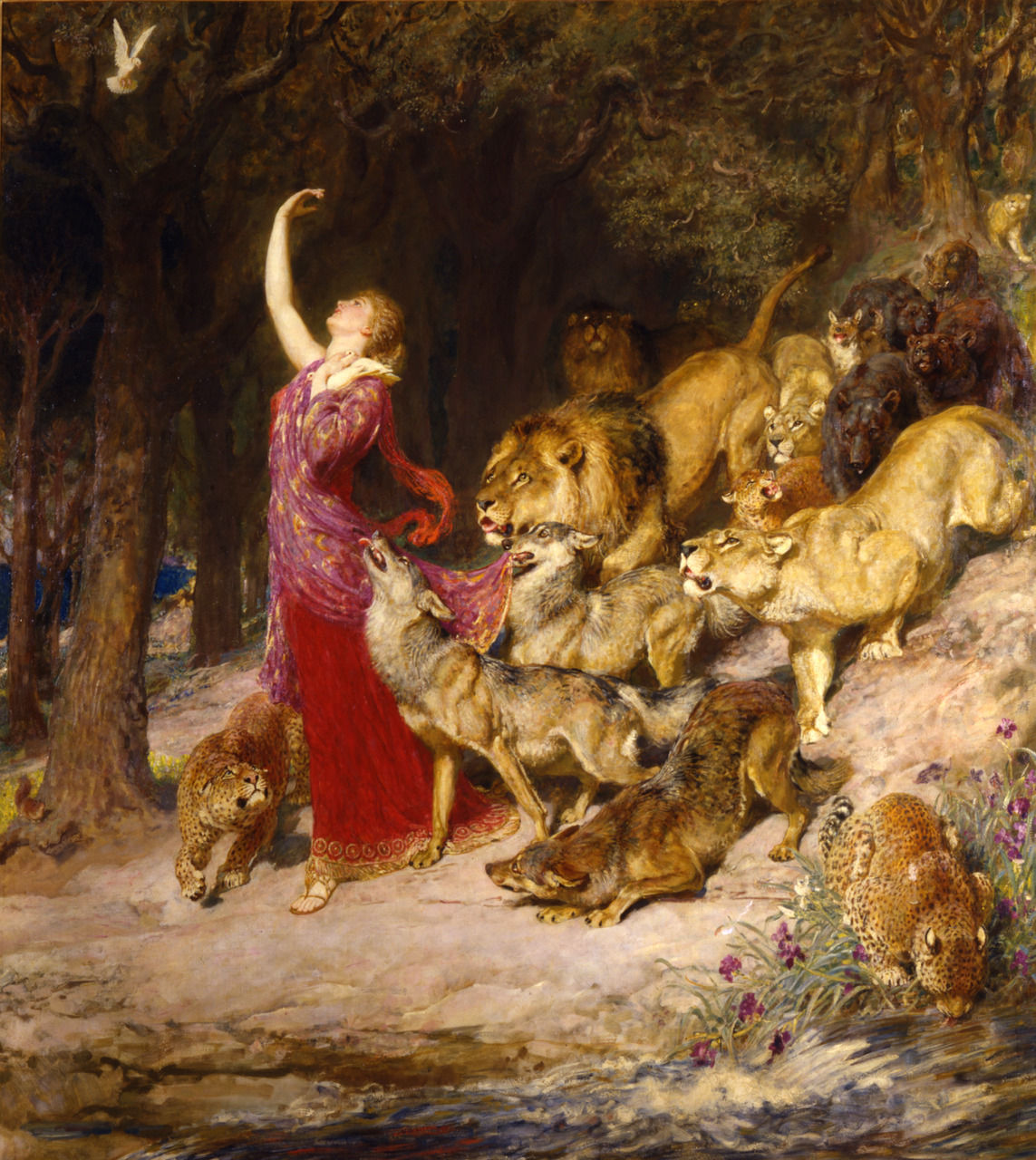
Breton Riviere (1840-1920) , Aphrodite, 1902. Reproduced with Permission from the Dahesh Museum of Art, New York City, NY, US. Public Domain. https://commons.wikimedia.org/wiki/File:Briton_Rivière_-_Aphrodite_02.jpg.
By Briton Rivière – http://19thcenturybritpaint.blogspot.it/2012/11/briton-riviere.html – image, Public Domain, https://commons.wikimedia.org/w/index.php?curid=33096754
Drawing from a Homeric hymn to Aphrodite (8th-6th Century BC). The French Huguenot painter Breton Riviere (1840-1920) creates a fantastic vision of Aphrodite (painted in 1902) walking alongside different animals. She is described as “the one from Cyprus, who arouses sweet desire for gods and who subdues the populations of mortal humans and birds as well, who fly in the sky, as well as all beasts—all those that grown on both dry land and the sea/They all know the things done by the one with the beautiful garlands, the one from Cytheria” (Dahesh Art Museum and Gallery Notes, Briton Riviere, Aphrodite (daheshmuseum.org).
Breton Riviere’s paintings of animals reflect a deep love for nature and its inhabitants. Inspired by the majesty of the animal kingdom and also the artistic style of Edwin Landseer, the animals in Riviere’s paintings reflect precision and a gentle majesty and beauty. On the back of his painting, Riviere made a note of the specific Homeric verse:
Homeric Hymn to Aphrodite (Lines 65-75)
Then she wrapped all her beautiful clothes around her skin.
She was decked out in gold, Aphrodite, lover of smiles.
She rushed toward Troy, leaving behind fragrant Cyprus.
Making her way with the greatest of ease, high among the clouds.
She arrived at Mount Ida, famous for its many springs, nurturing mother of beasts.
She went straight for the herdsman’s homestead, up over the mountain. Following her came
Grew wolves and lions and fierce looks, fawning on her;
Bears too, and nimble leopards, who cannot have their fill of devouring deer,
Came along….
Source: The Centre for Hellenic Studies, Harvard University, Cambridge, Massachusetts, US. (see below for the link).
For more, please follow the links below:
Project Gutenberg eBook: Mythology in Marble by Louie M. Bell. Boston, New York, Educational Pub. Co, 1901.
https://www.gutenberg.org/files/63157/63157-h/63157-h.htm
E-text prepared by Charlene Taylor, Charlie Howard,
and the Online Distributed Proofreading Team
(http://www.pgdp.net)
from page images generously made available by
Internet Archive
(https://archive.org
To whom a thousand temples rise,
Gaily false in gentle smiles,
Full of love-perplexing wiles;
O goddess, from my heart remove
The wasting cares and pains of love.If ever thou hast kindly heard
A song in soft distress preferred,
Propitious to my tuneful vow,
A gentle goddess, hear me now.
Descend, thou bright immortal guest,
In all thy radiant charms confessed.Thou once didst leave almighty Jove
And all the golden roofs above:
The car thy wanton sparrows drew,
Hovering in air they lightly flew;
As to my bower they winged their way
I saw their quivering pinions play.The birds dismissed (while you remain)
Bore back their empty car again:
Then you, with looks divinely mild,
In every heavenly feature smiled,
And asked what new complaints I made,
And why I called you to my aid?What frenzy in my bosom raged,
And by what cure to be assuaged?
What gentle youth I would allure,
Whom in my artful toils secure?
Who does thy tender heart subdue,
Tell me, my Sappho, tell me who?Though now he shuns thy longing arms,
He soon shall court thy slighted charms;
Though now thy offerings he despise,
He soon to thee shall sacrifice;
Though now he freezes, he soon shall burn,
And be thy victim in his turn.Celestial visitant, once more
Thy needful presence I implore.
In pity come, and ease my grief,
Bring my distempered soul relief,
Favour thy suppliant’s hidden fires,
And give me all my heart desires.Source: All Poetry WebsiteProject Guteberg eBook of Poetry by Sappho: The Project Gutenberg eBook of The Poems of Sappho, by John Myers O’Hara.
Venus with Mirror
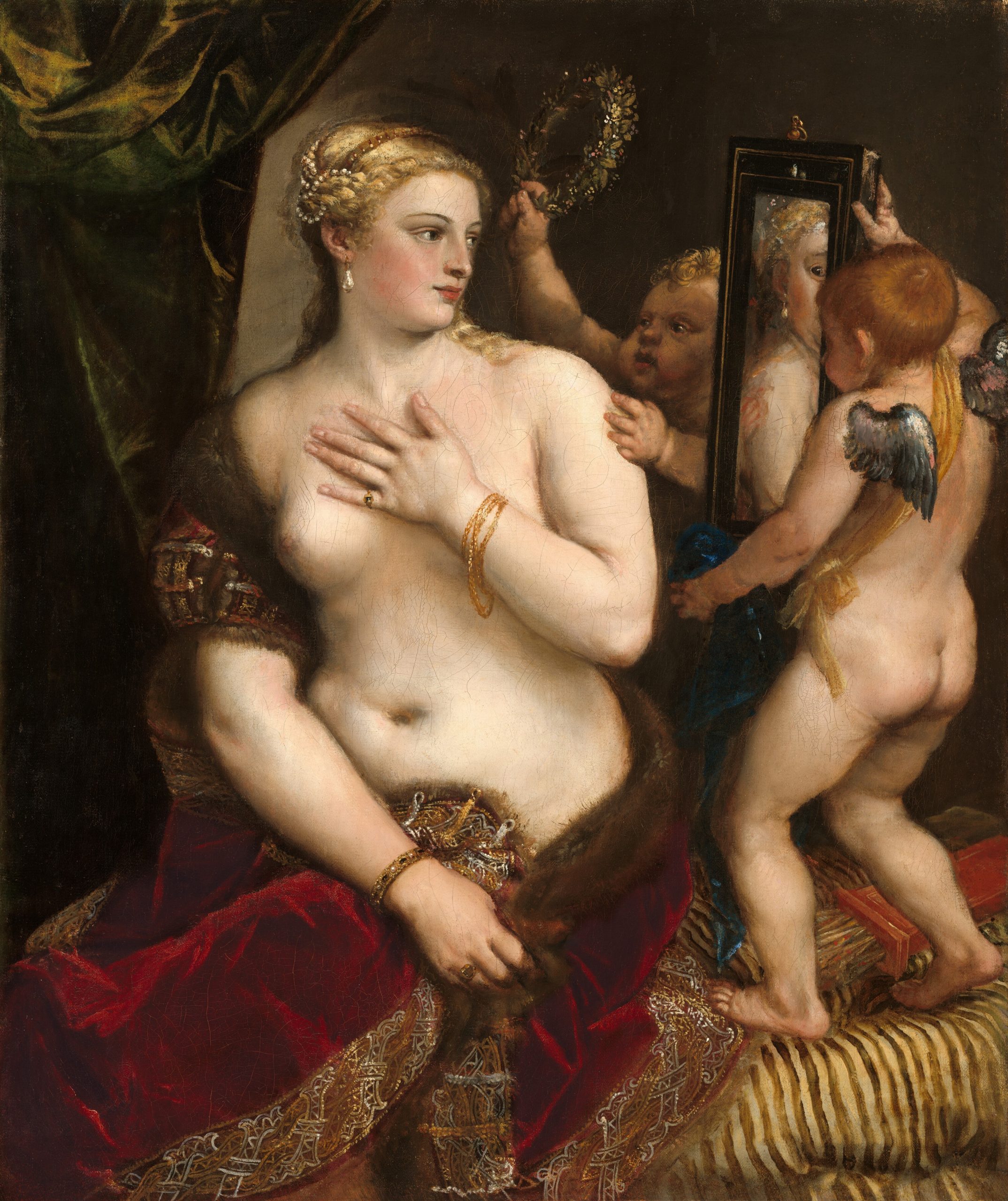
Titian (Tiziano Vecelli or Vecellio, 1488/90-1576). Venus with Mirror (close up). 1555. National Gallery of Art, Washington, DC. Public Domain. https://www.nga.gov/collection/art-object-page.41.html
For more on this collection, please follow the below link:
Venus Blindfolding Cupid
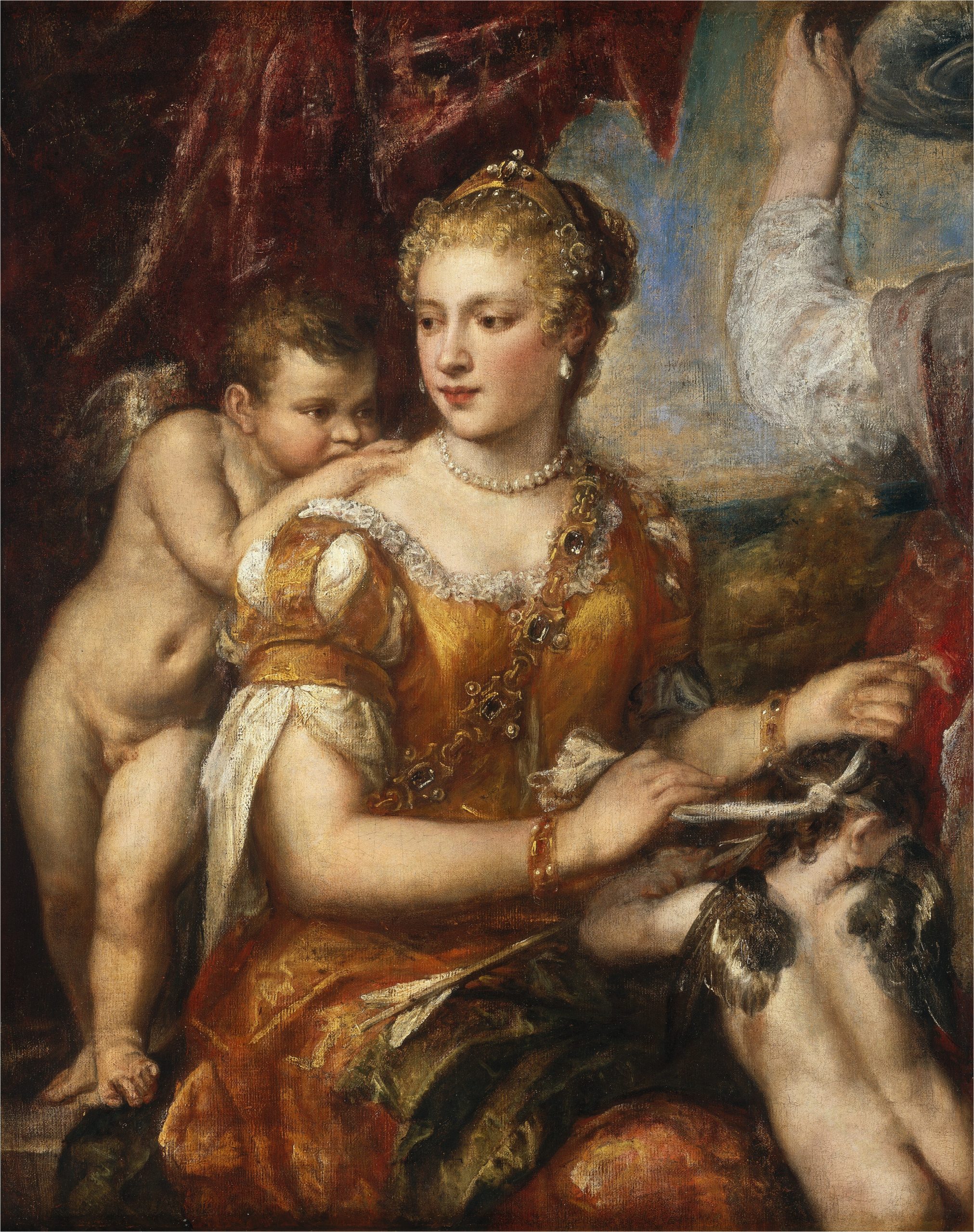
Unknown Artist (Workshop or Follower of Titian) Venus Blindfolding Cupid, National Gallery of Art, Washington, DC. Public Domain. https://upload.wikimedia.org/wikipedia/commons/a/a8/Workshop_or_Follower_of_Titian%2C_Venus_Blindfolding_Cupid%2C_c._1566-1570_or_c._1576-1580%2C_NGA_41594.jpghttps://commons.wikimedia.org/wiki/File:Workshop_or_Follower_of_Titian,_Venus_Blindfolding_Cupid,_c._1566-1570_or_c._1576-1580,_NGA_41594.jpg
For more information on Venus, please follow the link below:
Vulcan Catches Venus and Mars with a Net
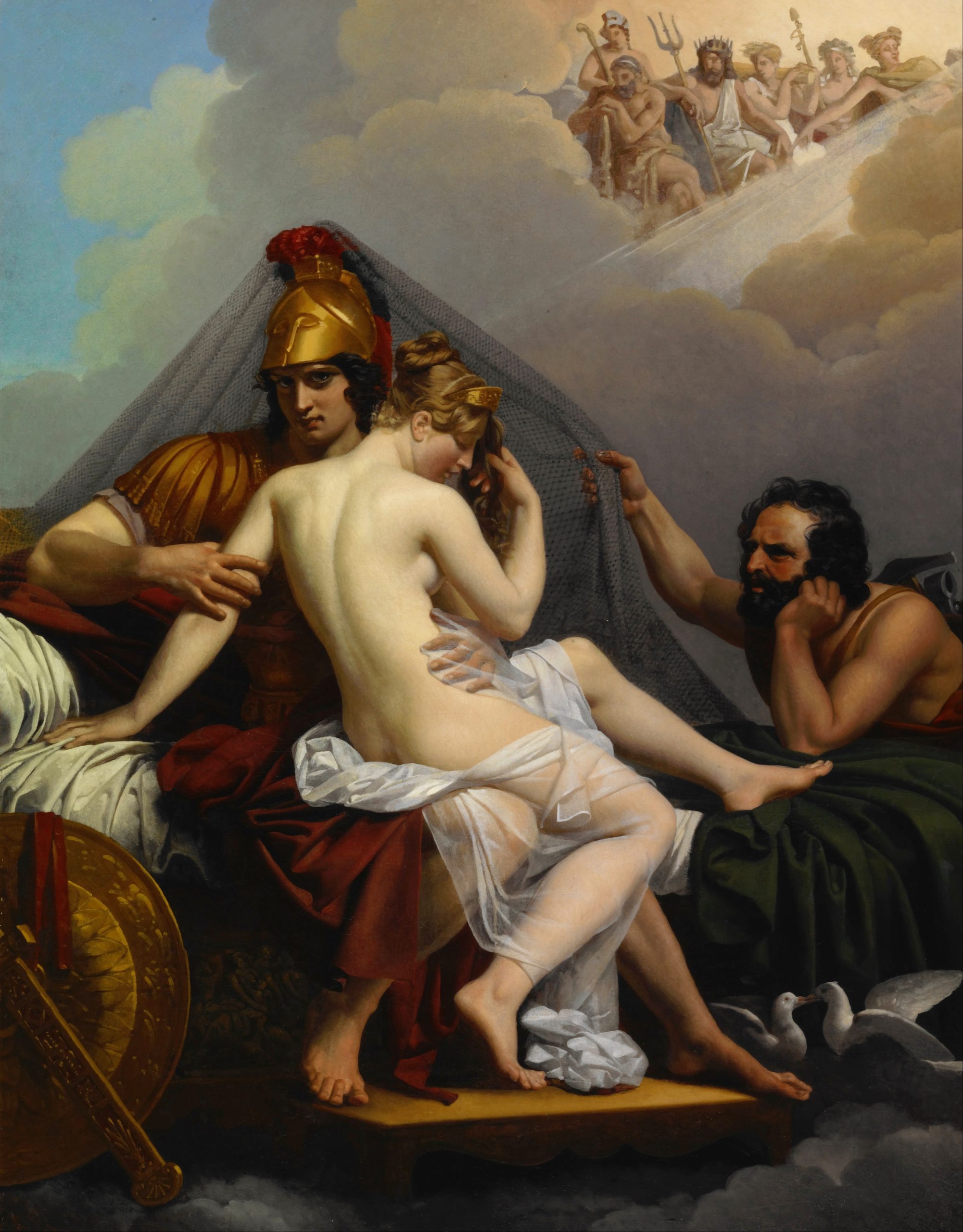
Alexander-Charles Guillemont, 1786-1831 Vulcan catches Venus and Mars with a Net, Oil on Canvas, 1781, Indianapolis Museum of Art, Indianapolis, Indiana, US. Public Domain.
Ceres, the goddess of Agriculture
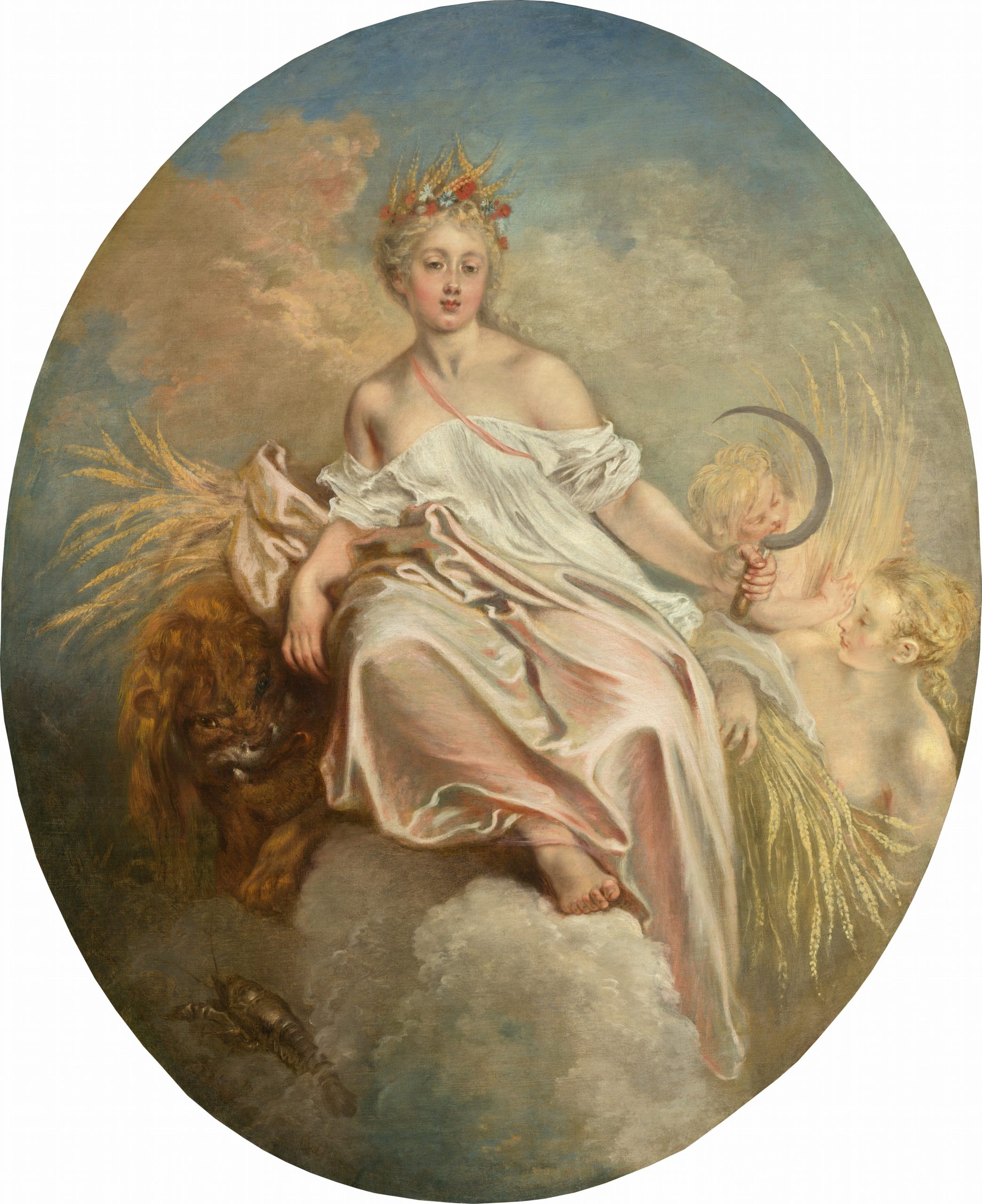
Antoine Watteau (1684-1721), Ceres, the goddess of Agriculture. 1712. National Gallery of Art, Washington, DC. Public Domain. https://www.nga.gov/collection/art-object-page.46149.html
Evelyn de Morgan (1855-1919) – Demeter Mourning for Persephone, 1906. De Morgan Centre, London, England. Public Domain.

By Evelyn De Morgan – [1], Public Domain, https://commons.wikimedia.org/w/index.php?curid=30643549res (Goddess of Agriculture) and Triptolemos (demi-god of the Eleusian mysteries)
The Myth of Demeter and Persephone (Excerpt from Mythology by Edith Hamilton (1867-1963) )
The myth of Demeter and Persephone is the story of the bond of love between a mother and daughter. In the myth, Persephone is abducted by Hades, lord of the underworld. Demeter is devastated and inconsolable at the disappearance of her daughter. In this excerpt, Edith Hamilton writes about the sorrow of both mother and daughter:
“Demeter’s only daughter was Persephone (Proserpine), the maiden of the spring. She lost her and in her terrible grief she withheld her gifts from the earth, which turned into a frozen desert. The green and flowering land was ice-bound and lifeless because Persephone had disappeared.
The lord of the dark underworld, the king of the multitudinous dead, carried her off when, enticed by the wondrous bloom of the narcissus, she strayed too far from her companions. In his chariot drawn by coal-black steeds he rose up through a chasm in the earth, and grasping the maiden by the wrist set her beside him. He bore her away weeping, down to the underworld. The high hills echoed her cry and the depths of the sea, and her mother heart it. She sped like a bird over the sea and land seeking her daughter. But no one would tell her the truth, ‘no man nor god, nor any sure messenger from the birds.’ Nine days Demeter wandered, and all that time she would not taste of ambrosia or put sweet nectar to her lips. At last she came to the Sun and he told her all the story: Persephone was done in the world beneath the earth, among the shadowy dead” (Hamilton, 1942/1969, p. 57).
Demeter’s mourning had a devastating impact on the earth. Nothing grew and the earth became like a wasteland; famine appeared to be imminent.
In the myth, Zeus intervenes and eventually, Demeter is reunited with Persephone, but only for short seasonal intervals. An arrangement was made with Hades, lord of the underworld, to “release” Persephone in the spring to see her mother and spend time with her:
“In the stories of both goddesses, Demeter and Persephone, the idea of sorrow was foremost. Demeter, goddess of the harvest wealth, was still more the divine sorrowing mother who saw her daughter die each year. Persephone was the radiant maiden of the spring and the summertime, whose light step upon the dry, brown hillside was enough to make it fresh and blooming, as Sappho writes,
‘I head the footfall of the flower spring…’
-Persephone’s footfall. But all the while Persephone knew how brief that beauty was; fruits, flowers, leaves, all the fair growth of the earth, must end with the coming of the cold and pass like herself into the power of death. After the lord of the dark world below carried her away she was never again the gay young creature who had played in the flowery meadow with a thought of care or trouble. She did indeed rise from the dead every spring, but she brought with her the memory of where she had come from; with all her bright beauty there was something strange and awesome about her. She was often said to be ‘the maiden whose name may not be spoken.’ ” (Edith Hamilton, Mythology, 1942/1969, p.62. Back Bay Books, Little Brown, & Co.). For additional references, please refer to the complete list of Resources and References at the end of these book sections.
eBook source for Thomas Bulfinch’s Golden Age of Myth and Legend https://mo01931486.schoolwires.net/cms/lib/MO01931486/Centricity/Domain/1584/BULFINCH%20Mythology_The%20Age%20of%20Fable.pdf
Demeter and Persephone by Alfred Lord Tennyson (1809-1892)
Excerpt:
All night across the darkness, and at dawn
Falls on the threshold of her native land,
And can no more, thou camest, O my child,
Led upward by the God of ghosts and dreams,
Who laid thee at Eleusis, dazed and dumb,
With passing thro’ at once from state to state,
Until I brought thee hither, that the day,
When here thy hands let fall the gather’d flower,
Might break thro’ clouded memories once again
On thy lost self. A sudden nightingale
Saw thee, and flash’d into a frolic of song
And welcome; and a gleam as of the moon,
When first she peers along the tremulous deep,
Fled wavering o’er thy face, and chased away
That shadow of a likeness to the king
Of shadows, thy dark mate. Persephone!
Queen of the dead no more — my child! Thine eyes
Again were human-godlike, and the Sun
Burst from a swimming fleece of winter gray,
And robed thee in his day from head to feet —
“Mother!” and I was folded in thine arms.”
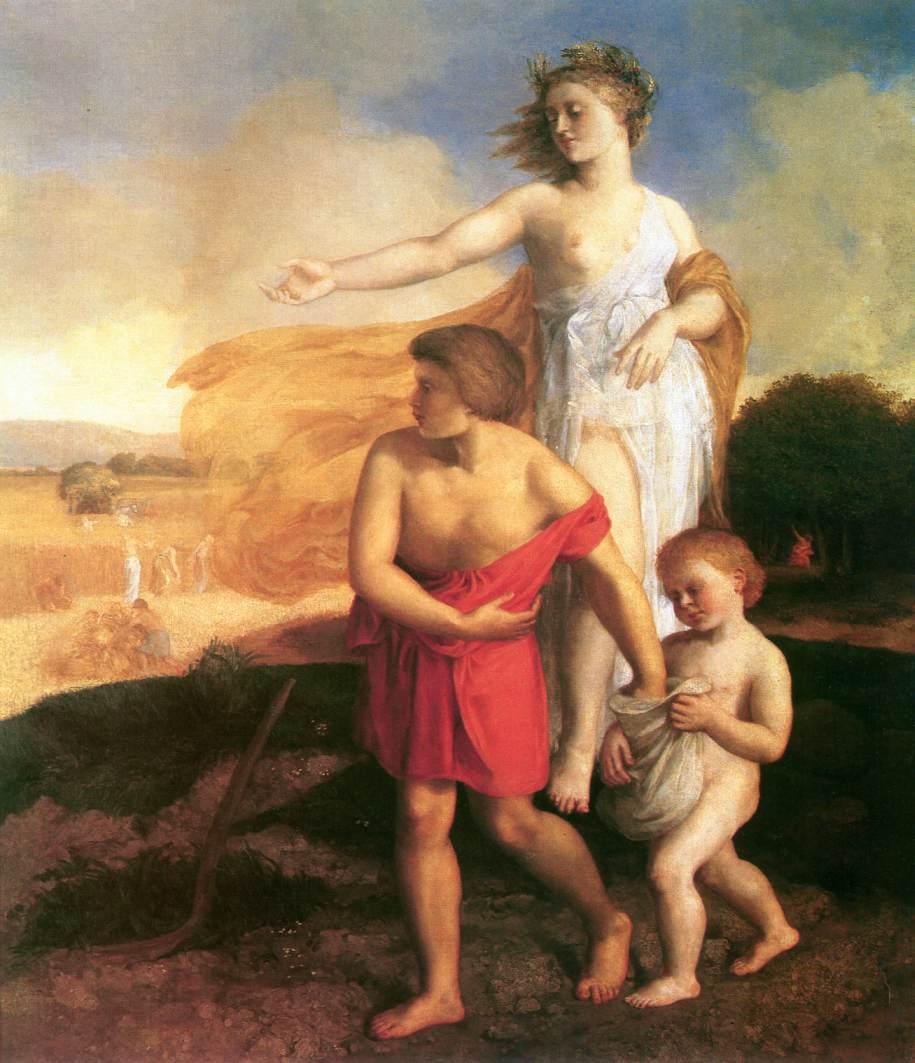
Károly Brocky (1808-1855) Ceres (Goddess of Agriculture) and Triptolemos (demi-god of the Eleusian mysteries; precided over grain and the milling of wheat). Otto Herman Museum, Budapest, Hungary. Public Domain. https://commons.wikimedia.org/wiki/File:Károly_Brocky_-_Ceres_and_Triptolemos.jpg
Proserpine: Journey to the Underworld (Hades)
Proserpine (meaning to “emerge”)
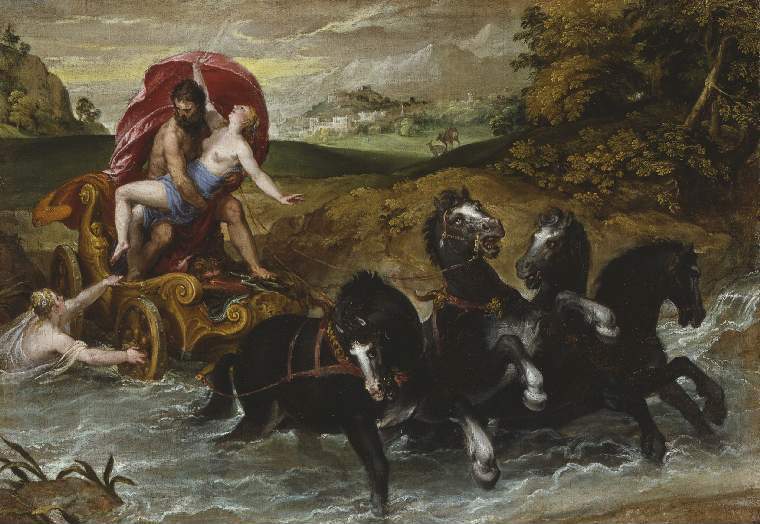
Christof Schwartz, 1548-1592, The Rape of Proserpine. 1572. Courtesy of The Fitzwilliam Museum, Cambridge, England, UK. Public Domain. The Fitzwilliam Museum – The Rape of Proserpine: 1778 (cam.ac.uk) https://data.fitzmuseum.cam.ac.uk/id/object/677
Excerpt from the Myth of Ceres and Proserpine, sorrow she stopped the fruits and vegetables from growing:
“In the vale of Enna there is a lake embowed in woods, which screen it from the fervid rays of the sun, while the moist ground is covered with flowers, and Spring reigns perpetual. Here Proserpine was playing with her companions gathering lilies and violets, and filling her basket and her apron with then, when Pluto saw her, loved her, and carried her off. She screamed for help to her mother and companions; and when in her fright she dropped the corners of her apron and let the flowers fall, childlike, she felt the loss of them as an addition to her grief. The ravisher urged on his steeds, calling them each by name, and throwing loose over their heads and necks his iron-coloured reinds. When he reached the River Cyane, and it opposed his passage, he struck the river-bank with his trident, and the earth opened and gave him a passage to Tartarus” (Thomas Bullfinch, The Golden Age of Myth and Legend, p.65).
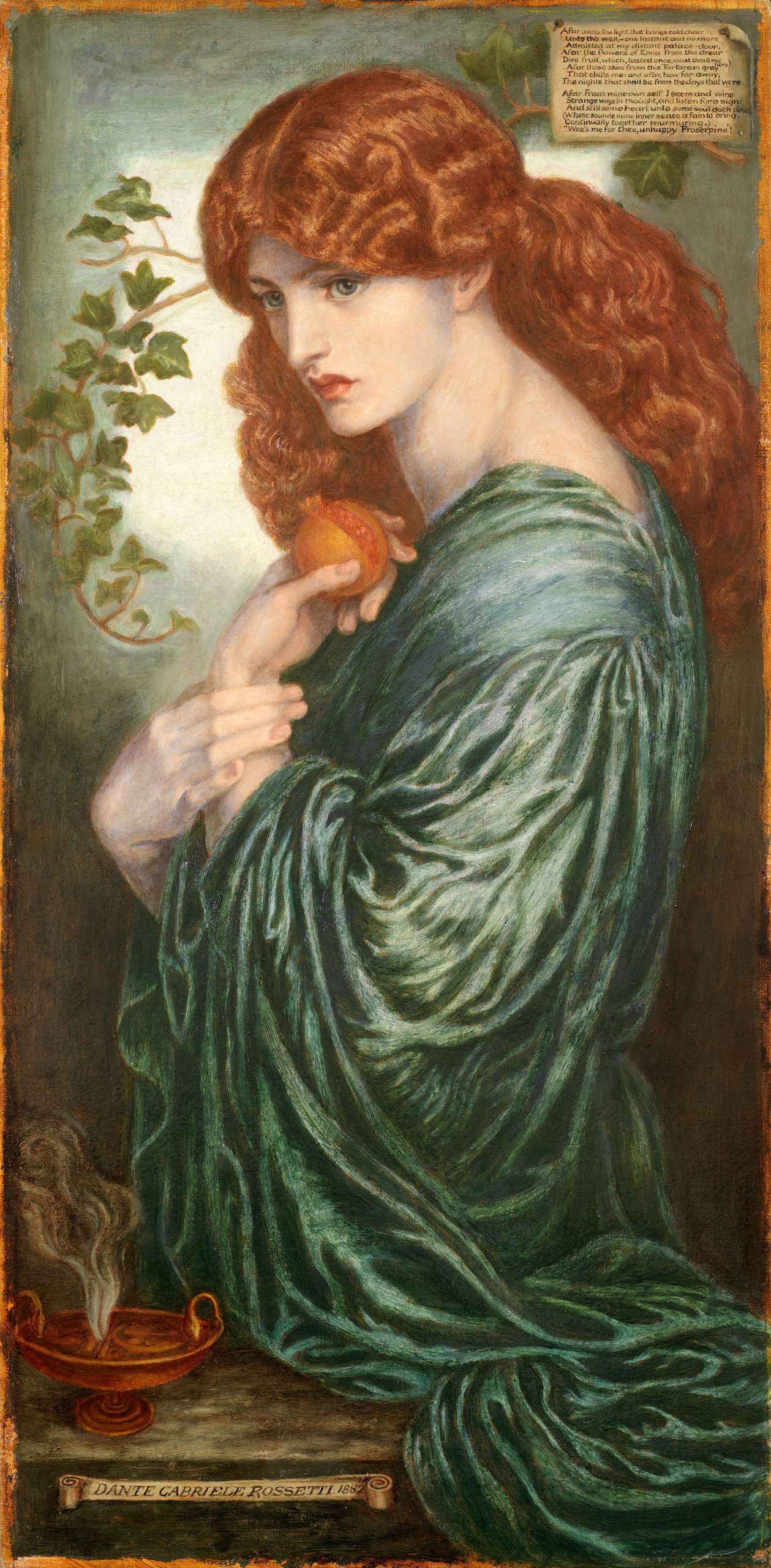
Dante Gabriel Rossetti (1828-1882). Proserpine (1881-1882). Birmingham Museums Trust, Birmingham, United Kingdom. Public Domain.
Courtesy: By Dante Gabriel Rossetti – Crop of File:8th Rossetti Proserpine.jpeg, Public Domain, https://commons.wikimedia.org/w/index.php?curid=90497915
In Hades
Hades, the Underworld
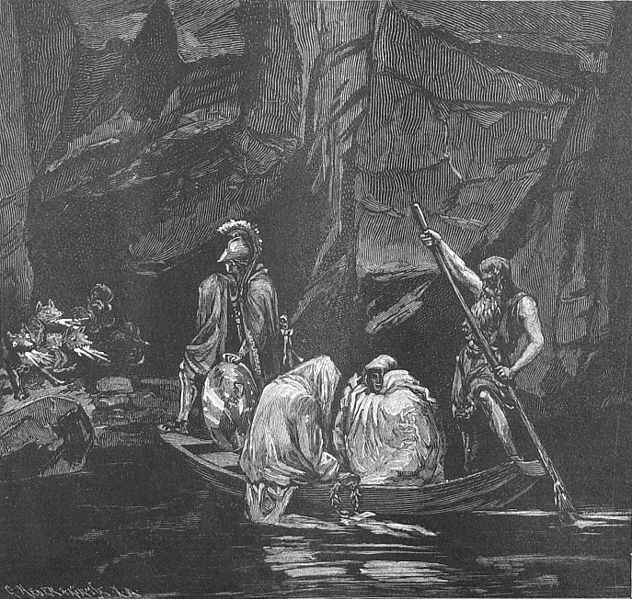
Ernst Keil Nachfolger (1816-1878). Hades the Underworld. (Illustration from p. 543, “Die Gartenlaube” 1886. Leipzig). Courtesy of Wikimedia Commons. Public Domain. https://en.wikipedia.org/wiki/File:Die_Gartenlaube_(1886)_b_543_2.jpg
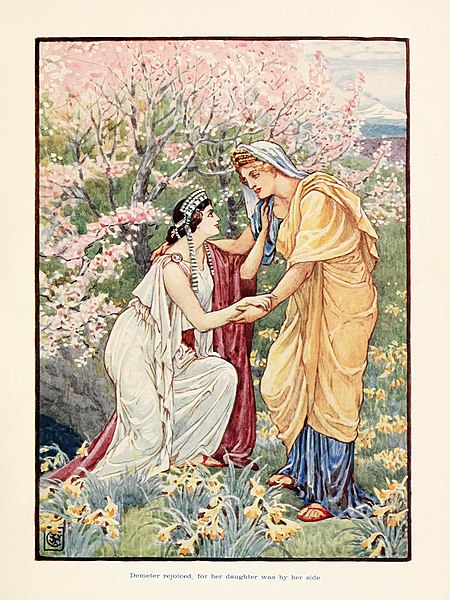
Walter Crane (1845-1919). Illustration of Demeter and Persephone. The Story of Greece: Told to Boys and Girls by Mary MacGregor (also known as Marion Keith) (1872-1961) and with colour plate illustrations by Walter Crane (1845-1919). T.C. & E.C. Jack, 1910 (illustrations by Walter Crane). Public Domain. https://commons.wikimedia.org/w/index.php?curid=32804547
For more information on Proserpine or (Persephone: “per-se-fone-nee”), please read and follow the link below:
The Story of Greece: Told to Boys and Girls
Project Gutenberg eBook of: The Story of Greece: Told to Boys and Girls by Mary MacGregor ( with nineteen plates in colour by Walter Crane). Thomas Nelson & Sons, 1960 (originally published in 1910 byT.C. & E.C. Jack)
https://www.gutenberg.org/files/66070/66070-h/66070-h.htm (PB eBook Produced by: Turgut Dincer, Charlie Howard, and the Online Distributed Proofreading Team at https://www.pgdp.net (This file was produced from images generously made available by The Internet Archive).
To learn more about the Canadian writer Marion Keith or Marion MacGregor please open the link below:
https://en.wikipedia.org/wiki/Mary_Esther_MacGregor#cite_note-londonculture-3
To view more of the brilliant artistry of Walter Crane, please open the link below.
https://en.wikipedia.org/wiki/Walter_Crane
The Return of Persephone
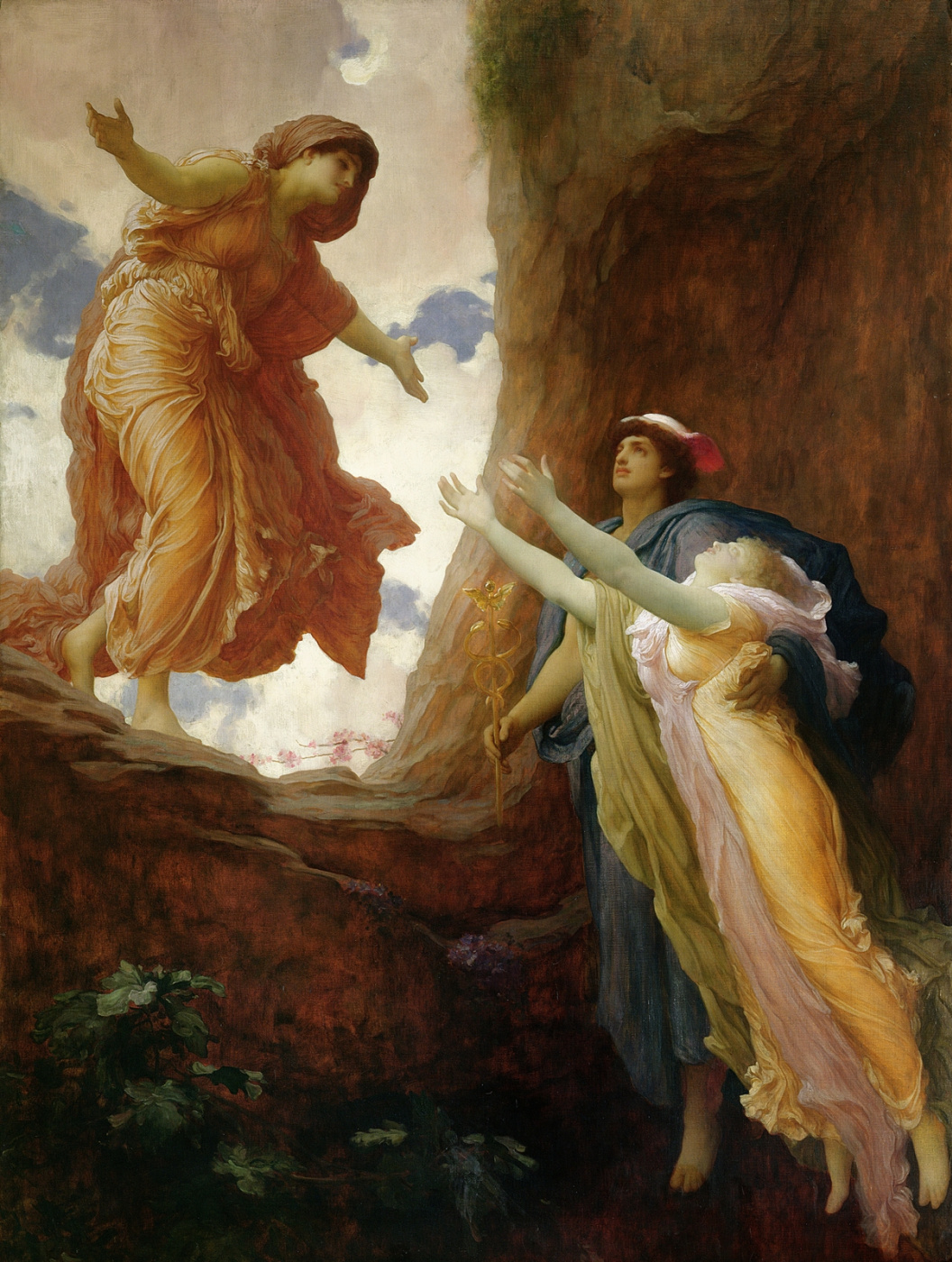
Frederic Leighton (1830-1896). The Return of Persephone. 1891. Oil on canvas. Wikimedia Commons & Art UK and the Leeds Art Gallery. Leeds, United Kingdom. Public Domain. https://commons.wikimedia.org/wiki/File:Frederic_Leighton_-_The_Return_of_Persephone_(1891).jpg
Flowers from Shakespeare’s Garden: Proserpina
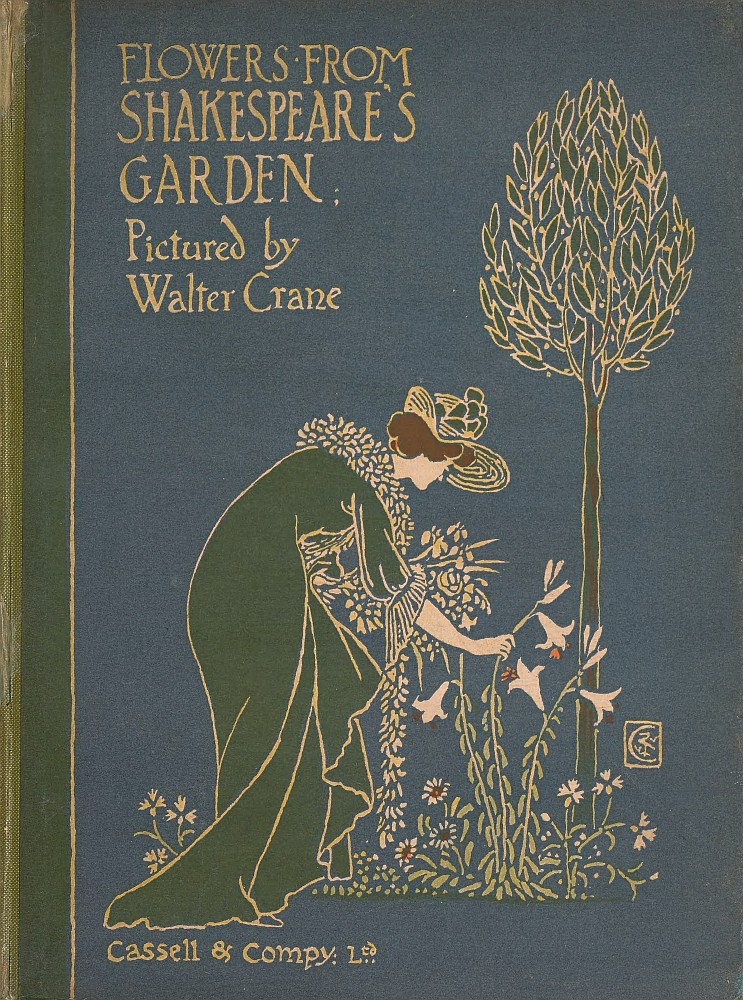
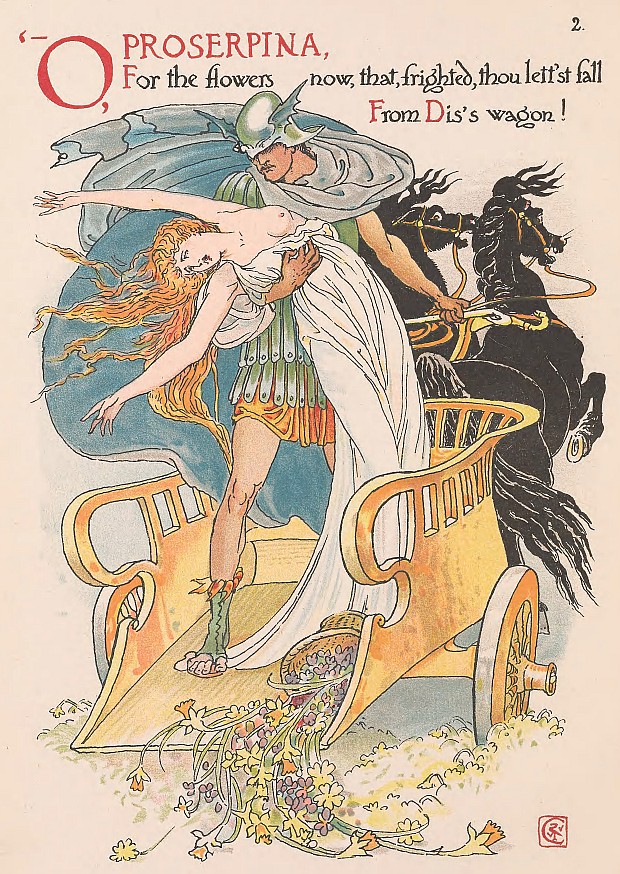
Minerva (Athena) in Art, Poetry, and Prose
Pallas Athena (Minerva)
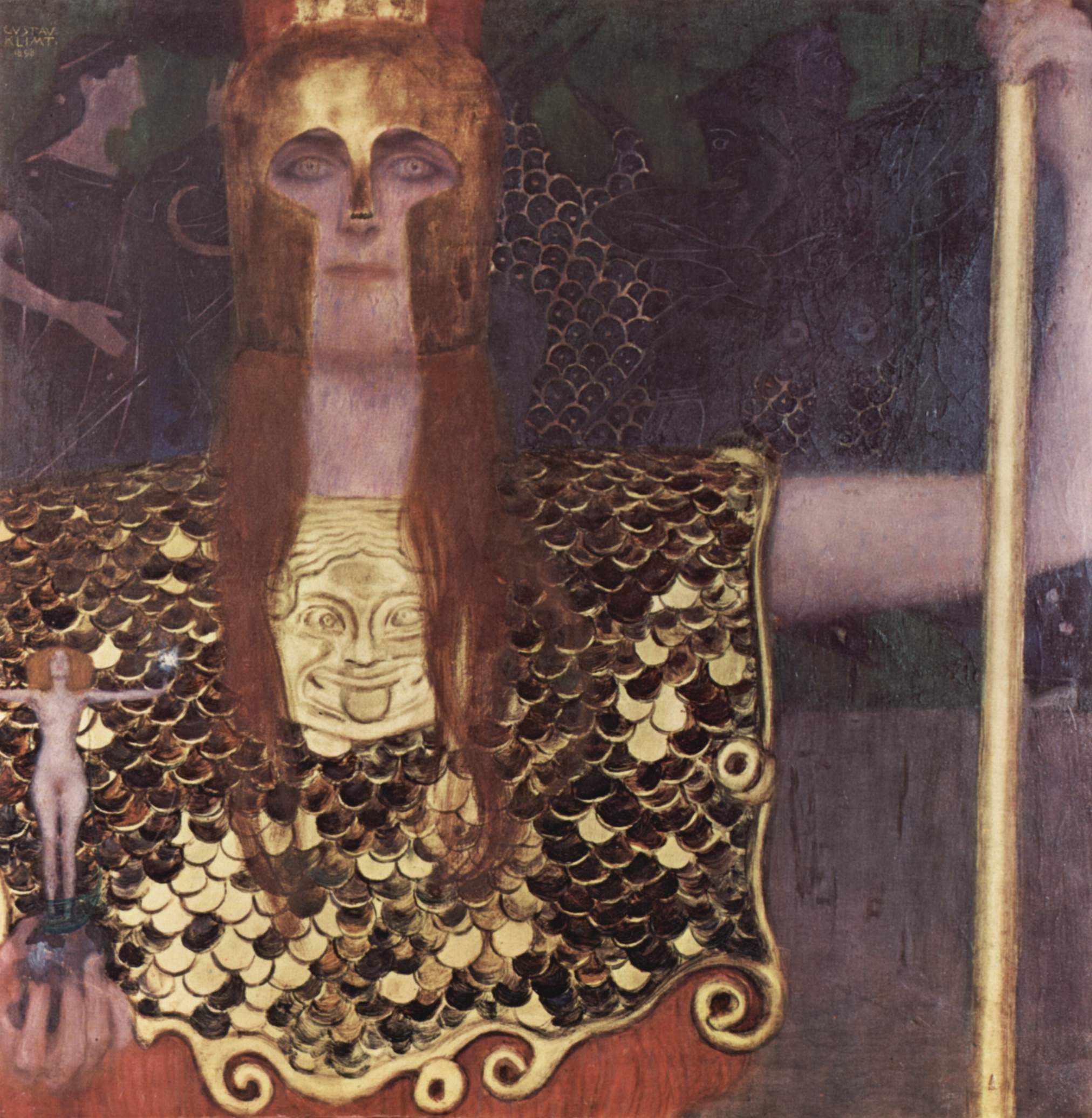
Gustav Klimt (1862-1918), Pallas Athena, 1898, Vienna Museum, Vienna, Austria. Public Domain. https://commons.wikimedia.org/w/index.php?curid=153484
Athena (Minerva in the Roman Myths )
Pallas Athena (Minerva), “the goddess of wisdom. was the offspring of Jupiter (Zeus), without a mother. She sprang forth from his head completely armed. Her favourite bird was the owl, and the plant sacred to her was the olive.” (Thomas Bulfinch (1796-1867). The golden age of myth and legend, Wordsworth Reference, 1993, p. 8).
Athena was thought to protect warriors in battle; in Klimt’s painting, she is depicted with a helmet, visor, and spear. Edith Hamilton (1942) writes:
“[Athena] was the daughter of Zeus alone. No mother bore her. Full-grown and in full armor, she sprang from his head. In the earliest account of her, the Iliad, she is a fierce and ruthless battle-goddess, but elsewhere she is warlike only to defend the State and the home form outside enemies. She was preeminently the Goddess of the City, the protector of civilized life, of handicrafts and agriculture; the inventor of the bridle, who first tamed horses for men to use.
She was Zeus’s favorite child. He trusted her to carry the awful aegis, his buckler, and his devastating weapon, the thunderbolt.
The word oftenest used to describe her is ‘gray-eyed’, or as it is sometimes translated, ‘flashing-eyed.’ Of the three virgin goddesses she was the chief and was called the Maiden, Parthenos, and her temple the Parthanon. In later poetry she is the embodiment of wisdom, reason, purity.
Athens was her special city; the olive created by her was her tree; the owl her bird” (Hamilton, 1942, p., 28).
Resource: Hamilton, E. (1942/1969). Mythology. Back Bay Books. Little, Brown, & Co.
For more information please open the link below:
Mars and Pegasus
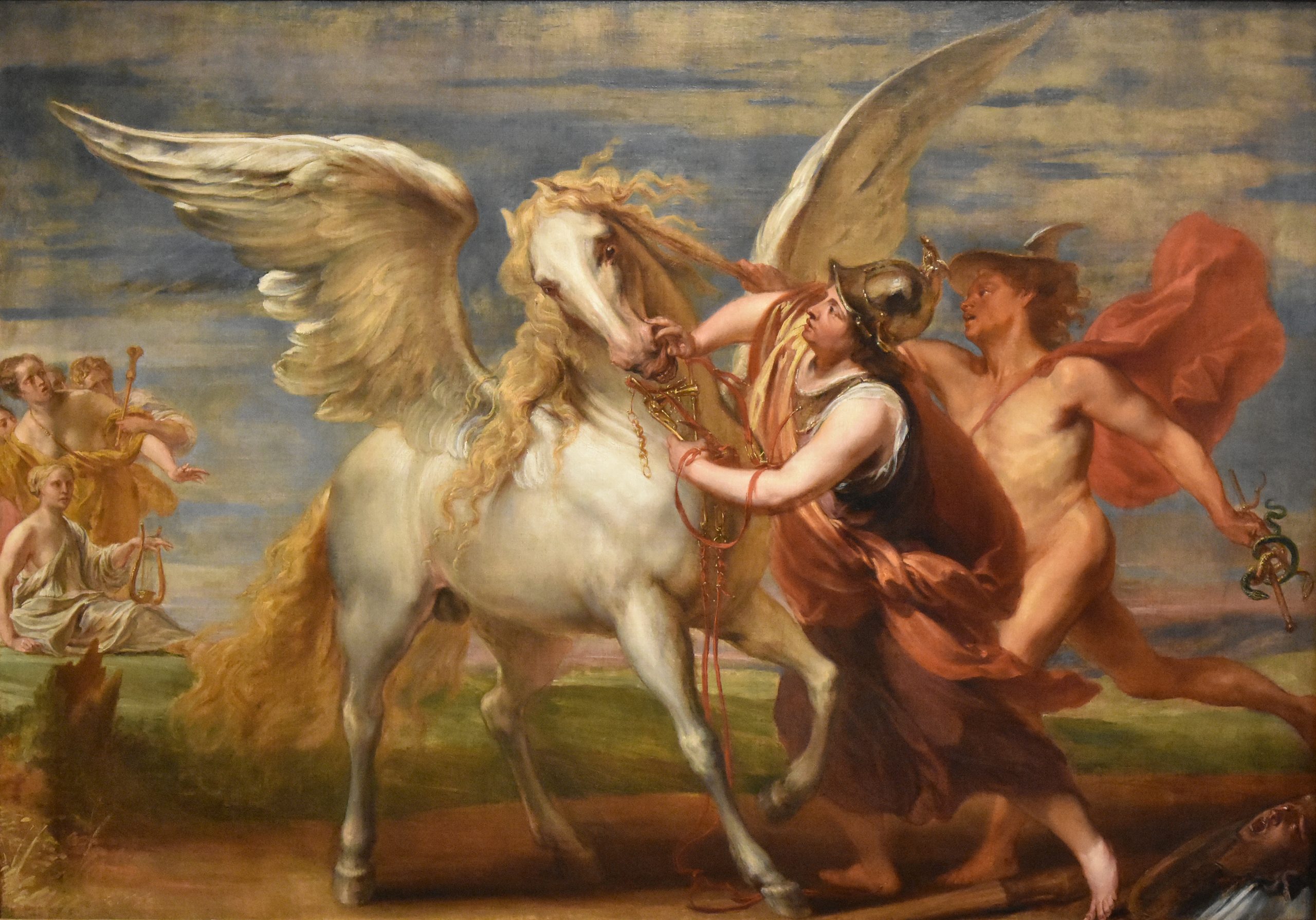
Jan Boeckhorst (1604-1668). Minerva, Mars, and Pegagus. Noordbrabants Museum, Netherlands, EU. Public Domain. https://upload.wikimedia.org/wikipedia/commons/2/2d/Jan_Boeckhorst_%281604-1668%29_Minerva_beteugelt_Pegasus_met_de_hulp_van_Mercurius_-_Noordbrabants_Museum_%27s-Hertogenbosch_26-8-2016.JPG
Athena Pays Invidia a Visit
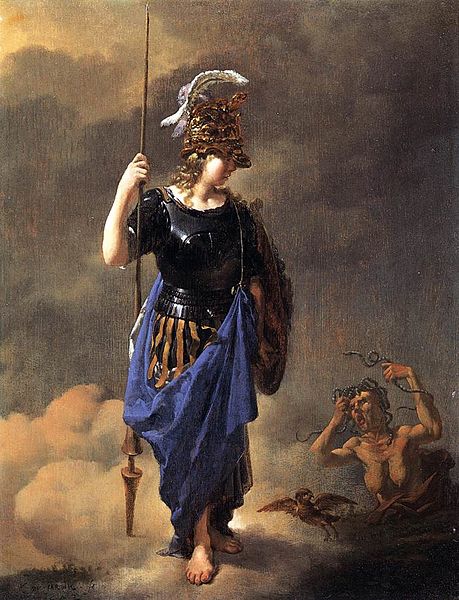
Karl Dujardin, 1662-1678, Athena pays Invidia a visit. Academy of Fine Arts, Vienna, Austria. Public Domain. https://commons.wikimedia.org/wiki/File:Karel_Dujardin_-_Pallas_Athene_Visits_Invidia,_1652.jpg
Minerva (Athena): Excerpt from The Golden Age of Myth and Legend by Thomas Bulfinch:
“Minerva (Athena) the goddess of wisdom, was the daughter of Jupiter (Zeus). She was said to have leaped forth from his brain, mature, and in complete armour. She presided over the useful and ornamental arts, both those of men—such as agriculture and navigation—and those of women—spinning, weaving, and needlework. She was also a warlike divinity; but it was defensive war only that she patronized and she had no sympathy with Mars’s love of violence and bloodshed. Athens was her chosen seat, her own city, awarded to her as the prize of a contest with Neptune, who also aspired to it. The tale ran that in the reign of Cecrops, the first king of Athens, the two deities contended for the possession of the city. The gods decreed that it should be awarded to that one who produced the gift most useful to mortals. Neptune gave the horse; Minerva produced the olive. The gods gave judgement that the olive was the more useful of the two, and awarded the city to the goddess; and it was named after her, Athens, her name in Greek meaning Athene” (Thomas Bulfinch (1796-1867), The Golden Age of Myth and Legend, p. 132).
Athene followed by Nike with Poseidon for the Possession of Attica
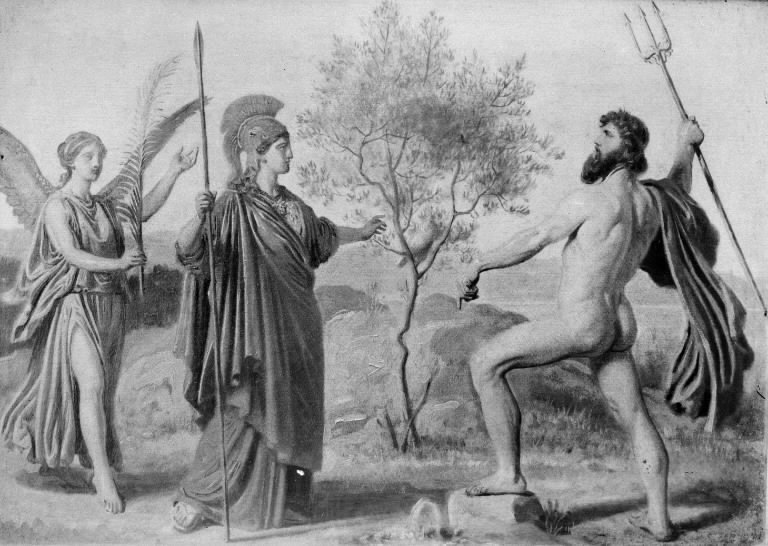
Constantine Hansen (1804-1880), Athene followed by Nike with Poseidon for the Possession of Attica, (painted between 1819-1880), Statens Museum for Kunst, Copenhagen, Denmark. Public Domain. https://upload.wikimedia.org/wikipedia/commons/b/ba/Constantin_Hansen_-_Athene_followed_by_Nike_Disputing_with_Poseidon_for_Possession_of_Attica_-_KMS4063_-_Statens_Museum_for_Kunst.jpg
Luna: Goddess of the Moon and Night
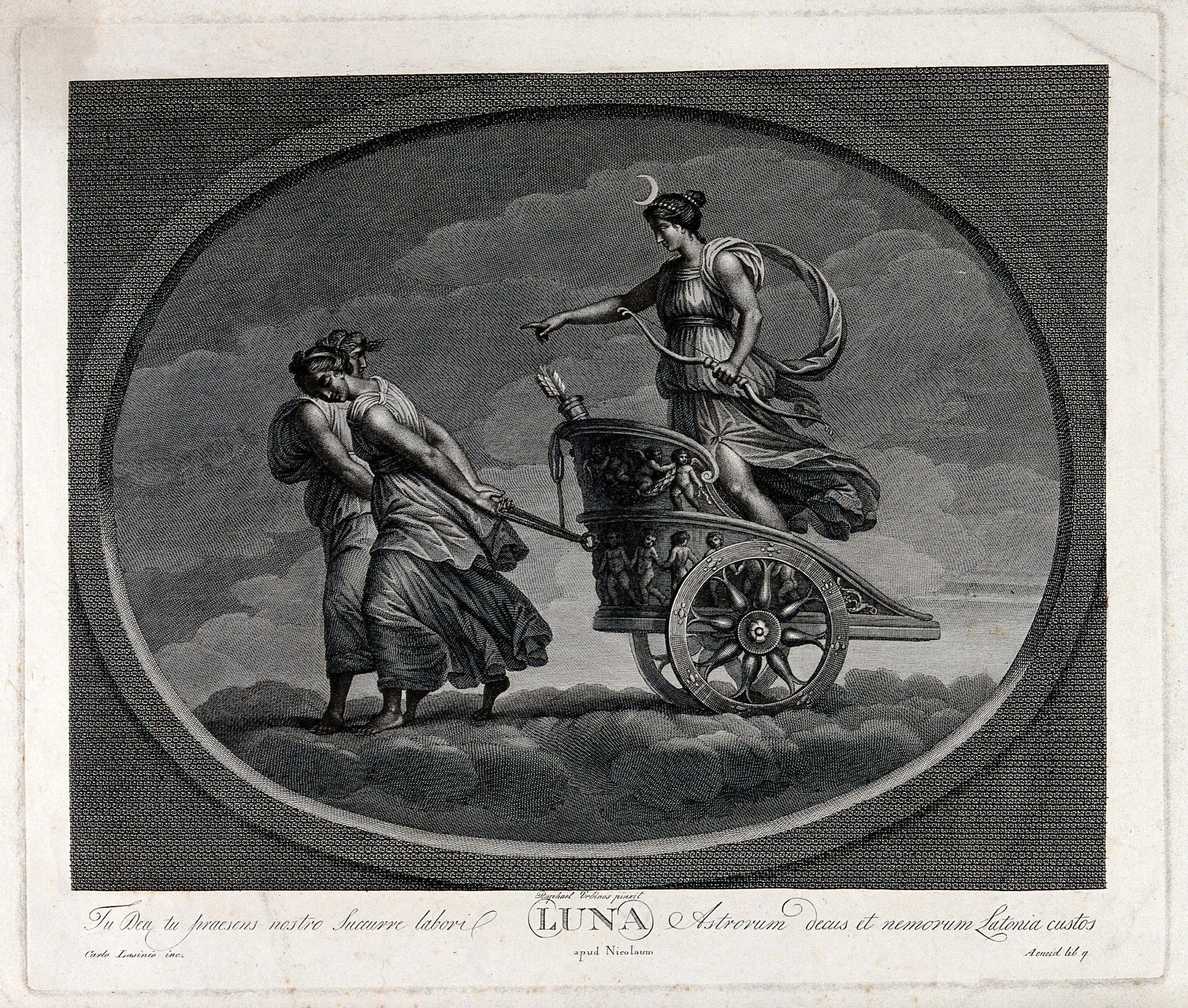
Carlos Lasinio (1759-1828). Luna, goddess of the moon and her chariot drawn by a pair of women. Steel Engraving, 1695, after Raphael (1516). CC BY: Public Domain Mark 1.0. https://wellcomecollection.org/works/cp3782z
Luna and Endymion
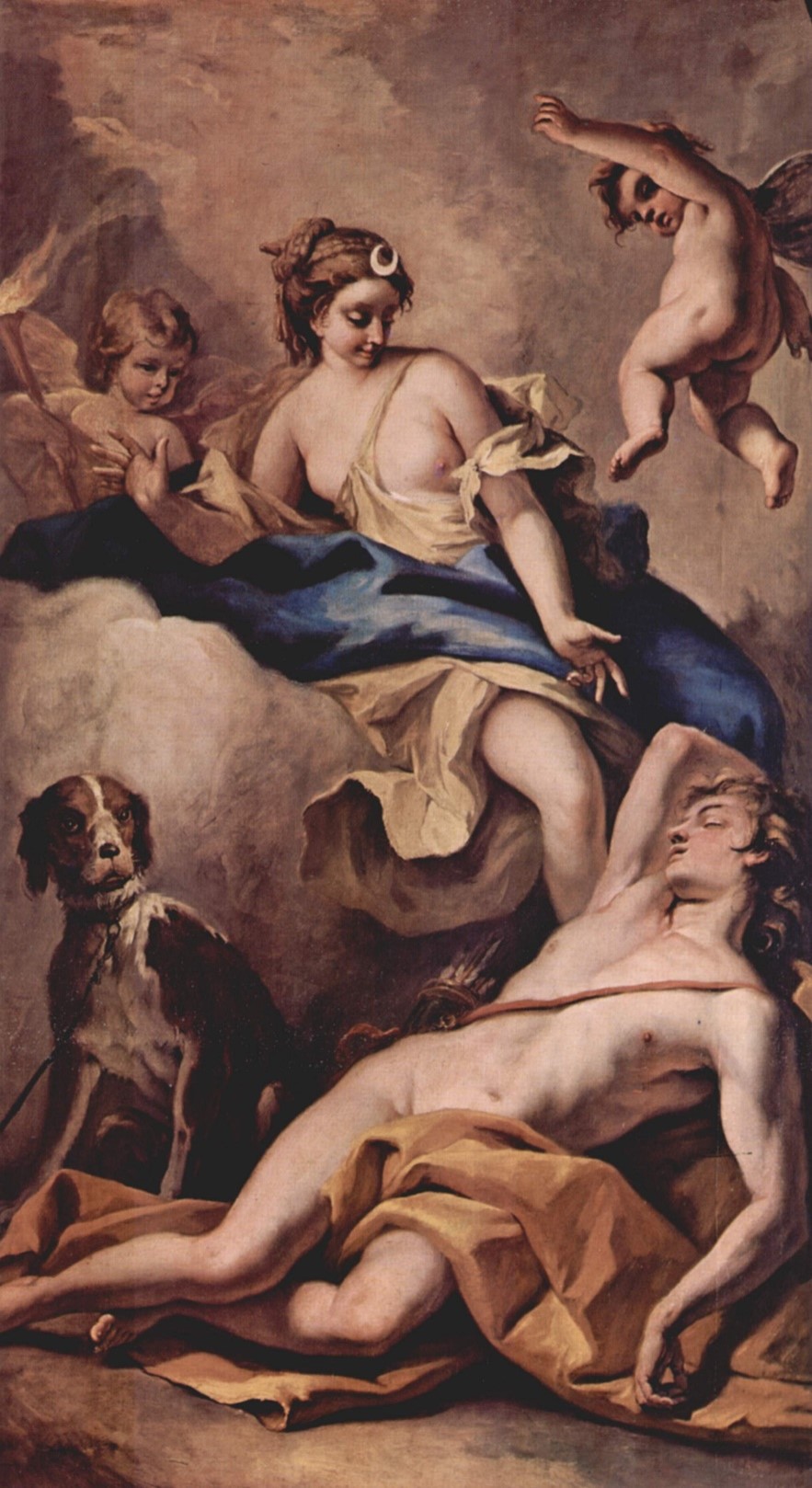
Sabastiano Ricci 1659–1732. Diane and Endymion. 1716. Oil on canvas. Art UK. London, United Kingdom, United Kingdom of Great Britain and Northern Ireland. Courtesy of Art UK. CC-BY-NC 4.0. https://artuk.org/discover/artworks/diana-and-endymion-178894
The myth of Diane (Luna) and Endymion is one of that emigrated from Greek to Roman mythology. However, this story acquired special significance for the Romans and became a theme in wall paintings and other forms of art. In this myth, Luna fell in love with the beautiful young shepherd Endymion. Jupiter had given him the gift of eternal youth and the ability to sleep whenever he wanted. His beauty amazed Luna to the extent that she came down from the heavens every night to protect him and watch him sleep.
Selene (Luna or Diana) visits Endymion
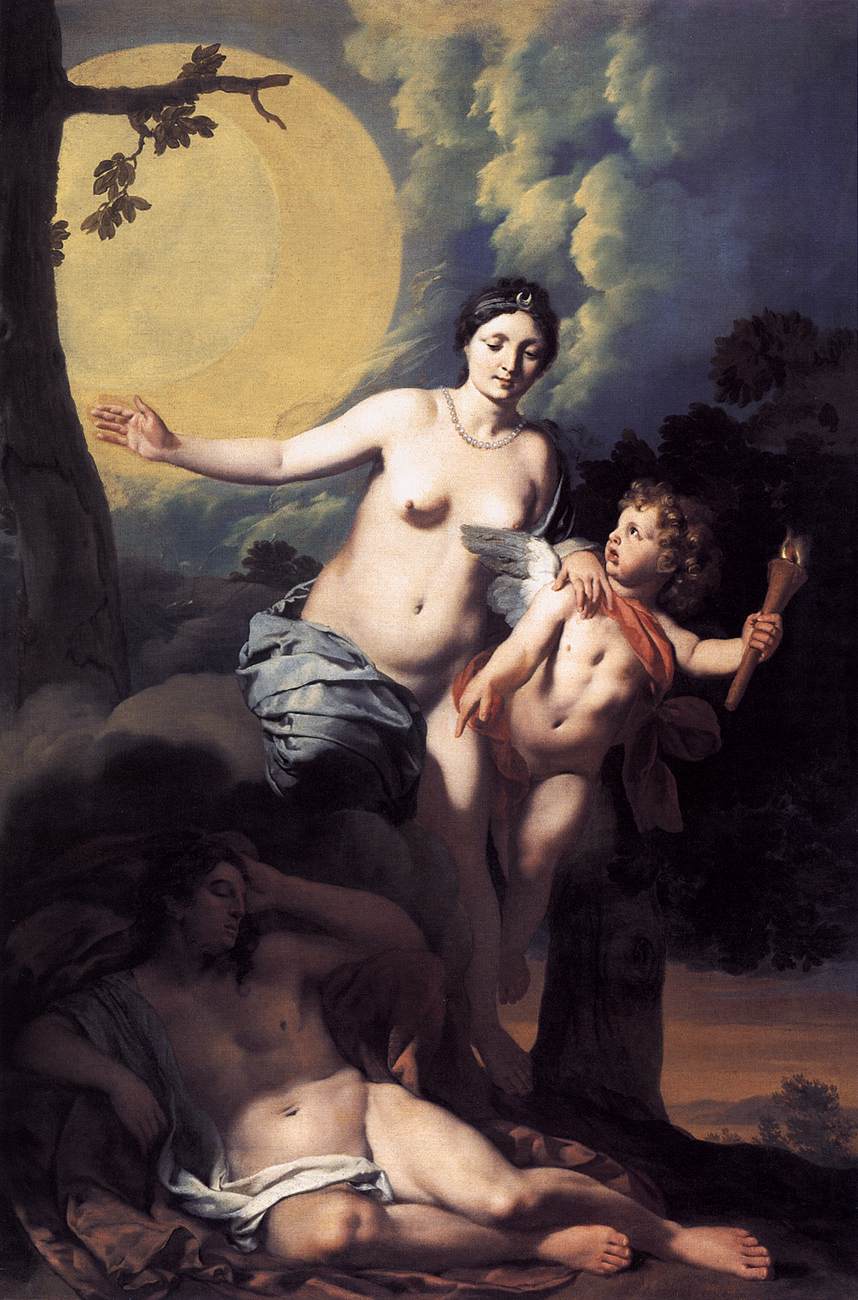
Gerard de Lairesse ( -1711), Diane (Luna) visits Endymion. 1680. Courtesy of Wikimedia Commons. Public Domain. by Gerard de Lairesse https://commons.wikimedia.org/wiki/File:1677_G%C3%A9rard_de_Lairesse_-_Diana.jpg
John Keat’s captures the existential conflict between the real world and the idealized ephemeral world of dreams, fantasy, and the imagination. This famous poem is based on the mythological Shepherd Endymion. Book I, lines 1-24. See also:
“Endymion” by John Keats (1795-1821)
A thing of beauty is a joy for ever
Its loveliness increases; it will never
Pass into nothingness; but still will keep
A bower quiet for us, and a sleep
Full of sweet dreams, and health, and quiet breathing.
Therefore, on every morrow, are we wreathing
A flowery band to bind us to the earth,
Spite of despondence, of the inhuman dearth
Of noble natures, of the gloomy days,
Of all the unhealthy and o’er-darkened ways
Made for our searching: yes, in spite of all,
Some shape of beauty moves away the pall
From our dark spirits. Such the sun, the moon,
Trees old, and young, sprouting a shady boon
For simple sheep; and such are daffodils
With the green world they live in; and clear rills
That for themselves a cooling covert make
‘Gainst the hot season; the mid forest brake,
Rich with a sprinkling of fair musk-rose blooms:
And such too is the grandeur of the dooms
We have imagined for the mighty dead;
All lovely tales that we have heard or read:
An endless fountain of immortal drink,
Pouring unto us from the heaven’s brink.[7]
Poetry Foundation (https://www.poetryfoundation.org/poems/44469/endymion-56d2239287ca5
Illustration of the Moon goddess Diane (Luna) thinking about the Shepherd Endymion
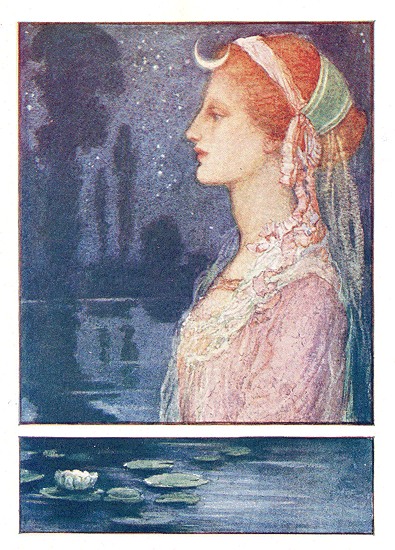
W. J. Neatby (1860-1910) Illustration of the moon goddess Selene thinking about the shepherd Endymion. In May Byron (1861-1936) Greeting a New Day with John Keats. Hodder and Stoughton. 1911. Public Domain. https://commons.wikimedia.org/wiki/File:Greeting_a_New_Day.jpg
The Moon by Robert Louis Stevenson (1850-1894)
The moon has a face like the clock in the hall;
She shines on thieves on the garden wall,
On streets and fields and harbor quays,
And birdies asleep in the forks of the tree.
The squalling cat and the squeaking mouse,
The howling dog by the door of the house,
The bat that lies in bed at noon,
All love to be out by the light of the moon.
But of all the things that belong to the day
Cuddle to sleep to be out of her way
And flowers and children close their eyes
Till up in the morning the sun shall arise.
Source: https://www.familyfriendpoems.com/poem/the-moon-by-robert-louis-stevenson
Learning Objectives
For more poetry and prose by Robert Louis Stevenson, please open the link below:
A Child’s Garden of Verses
https://www.gutenberg.org/cache/epub/136/pg136.html
Diane (Luna) and Endymion
https://upload.wikimedia.org/wikipedia/commons/4/42/Selene_and_Endymion.jpg
Other Works:
Night with Her Train of Stars
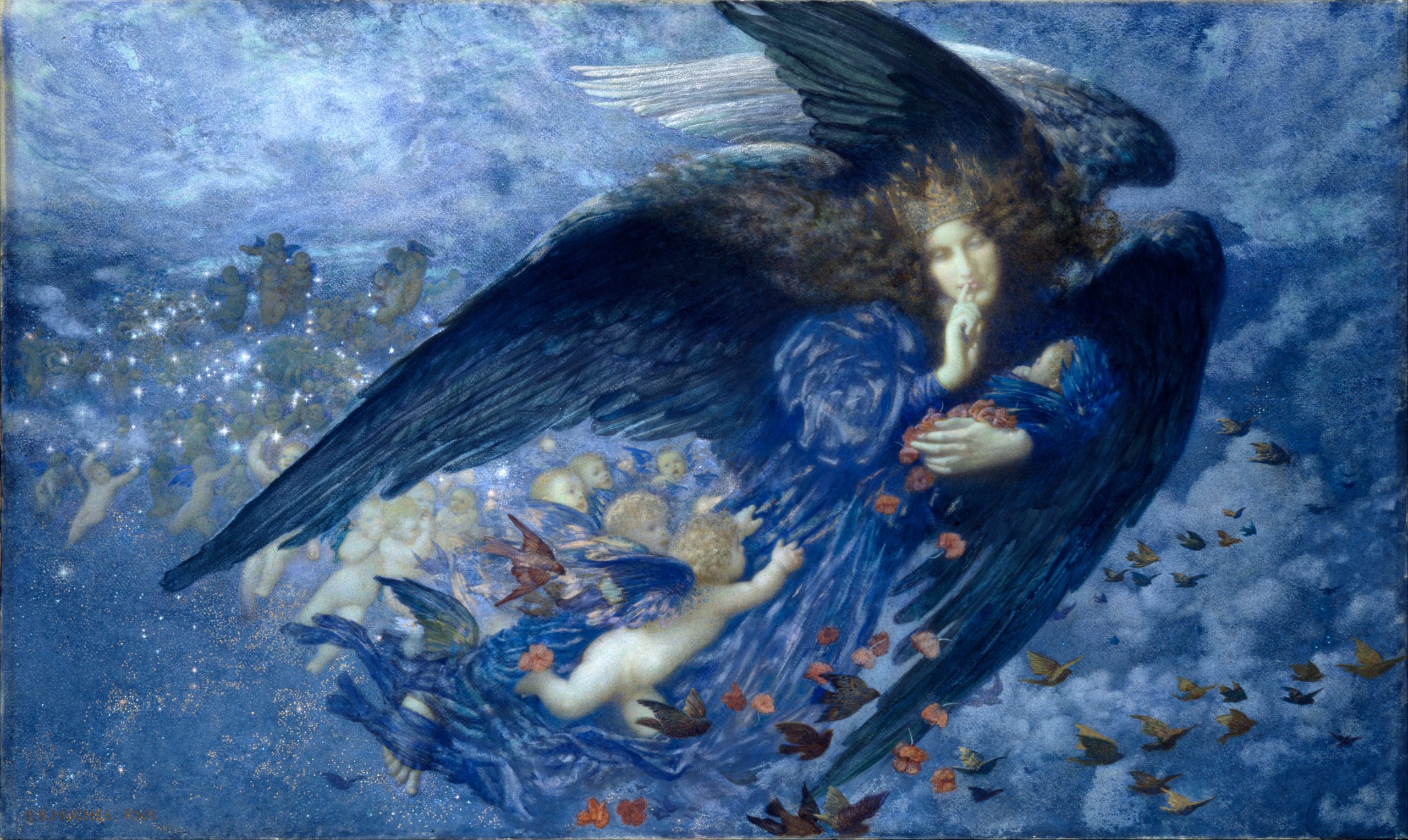
Edward Robert Hughes (1851-1914), Night with her train of stars by Robert Hughes, 1912, Birmingham Art Gallery, Birmingham, England. Courtesy: Birmingham Museum and Art Gallery. Public Domain. Birmingham Museum Trust. https://commons.wikimedia.org/wiki/File:Edward_Robert_Hughes_-_Night_with_her_Train_of_Stars_-_Google_Art_Project.jpg
E. Henley’s (1849-1903) poem ‘Margaritae Sorori‘:
A late lark twitters from the quiet skies:
And from the west,
Where the sun, his day’s work ended,
Lingers as in content,
There falls on the old, gray city
An influence luminous and serene,
A shining peace.
The smoke ascends
In a rosy-and-golden haze. The spires
Shine and are changed. In the valley
Shadows rise. The lark sings on. The sun,
Closing his benediction,
Sinks, and the darkening air
Thrills with a sense of the triumphing night
Night with her train of stars
And her great gift of sleep.
So be my passing!
My task accomplish’d and the long day done,
My wages taken, and in my heart
Some late lark singing,
Let me be gather’d to the quiet west,
The sundown splendid and serene,
Death.
Source: http://www.bmagic.org.uk/objects/1915P100 – Iconographic Collections
Zeus and Europa
Rembrandt, The Abduction of Europa
Europa was a Phoenician princess and the mother of King Minos from Crete. In Book III “The Wrath of Juno” Ovid describes the many escapades and affair of Juno (Zeus). In one episode, Juno disguises himself as a white bull; he abducts the princess Europa and carries her away to another continent (now called Europe). The onlookers and Europa are bewildered and astonished. Rembrandt is able to describe the powerful narrative with careful attention to emotion, action, and setting. While sunlight and blue skies are featured, there are also heavy dark clouds that are more ominous.
“And now, his taurine imitation ended,
The god exposed himself for what he was
To cowed Europa on the isle of Crete.
In an action both paternal and perverse,
The captured maiden’s baffled father bids,
Her brother Cadmus to locate the girl
Or face an endless term of banishment.
His search was fruitless, for who can discover
Jove’s secret snatches?
(Charles Martin, Ed. 2004. Ovid Metamorphses, Book III, The Wrath of Juno, p.94).
The Abduction of Europa by Zeus
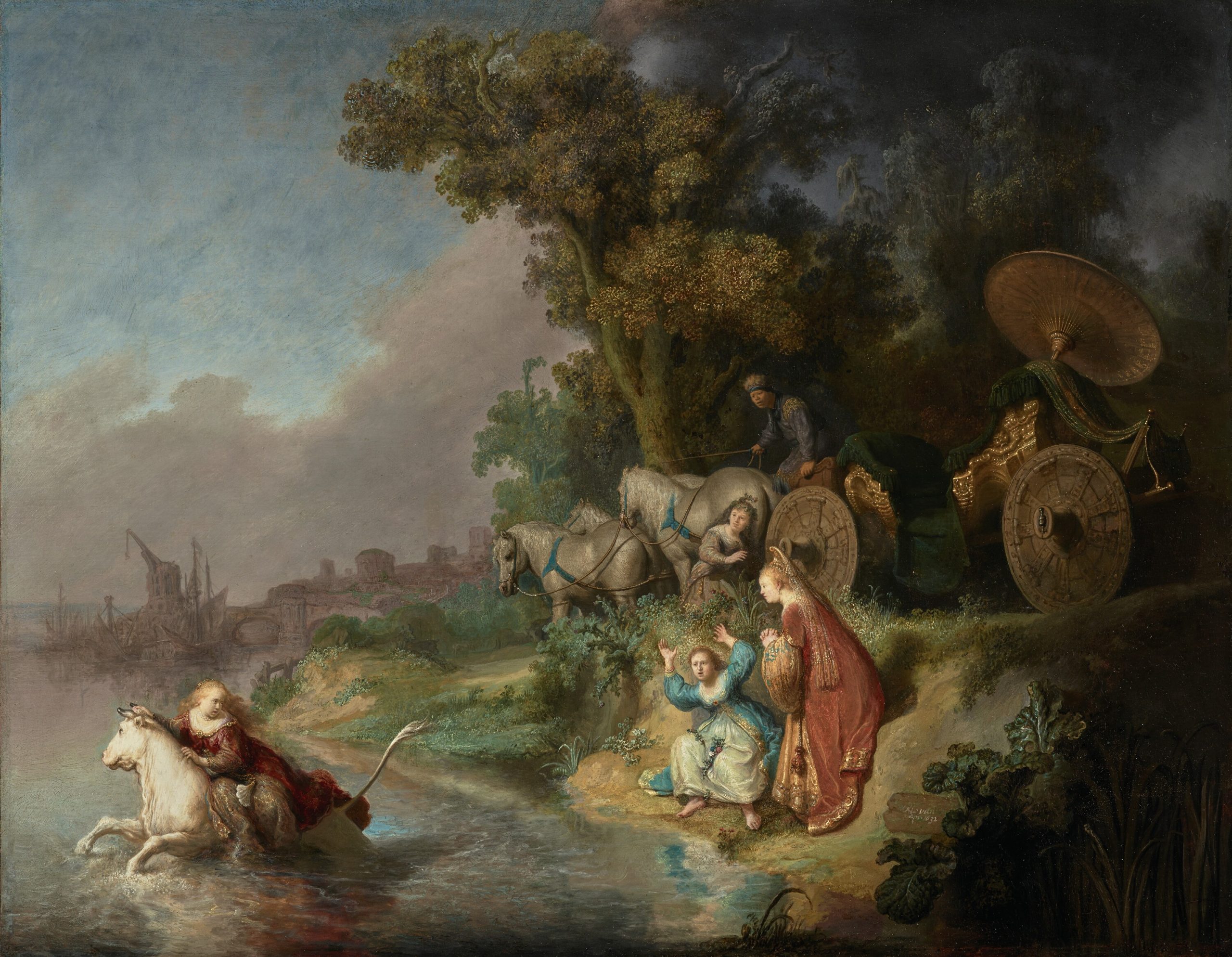
Rembrandst Harmenszoon van Rijn (1606-1669). The Abduction of Europa. 1632. Getty Art Centre, Los Angeles, California. Public Domain. https://www.getty.edu/art/collection/object/103QS8
Learning Objectives
To read and view an illustrated version of Myths and Legends from all nations by Logan Marshall, please open the link below:
https://archive.org/details/mythslegendsofal00mars/page/n3/mode/2up
- Includes Myths and legends of all nations; famous stories from the Greek, German, English, Spanish, Scandinavian, Danish, French, Russian, Bohemian, Italian and other sources
Orpheus and Eurydice
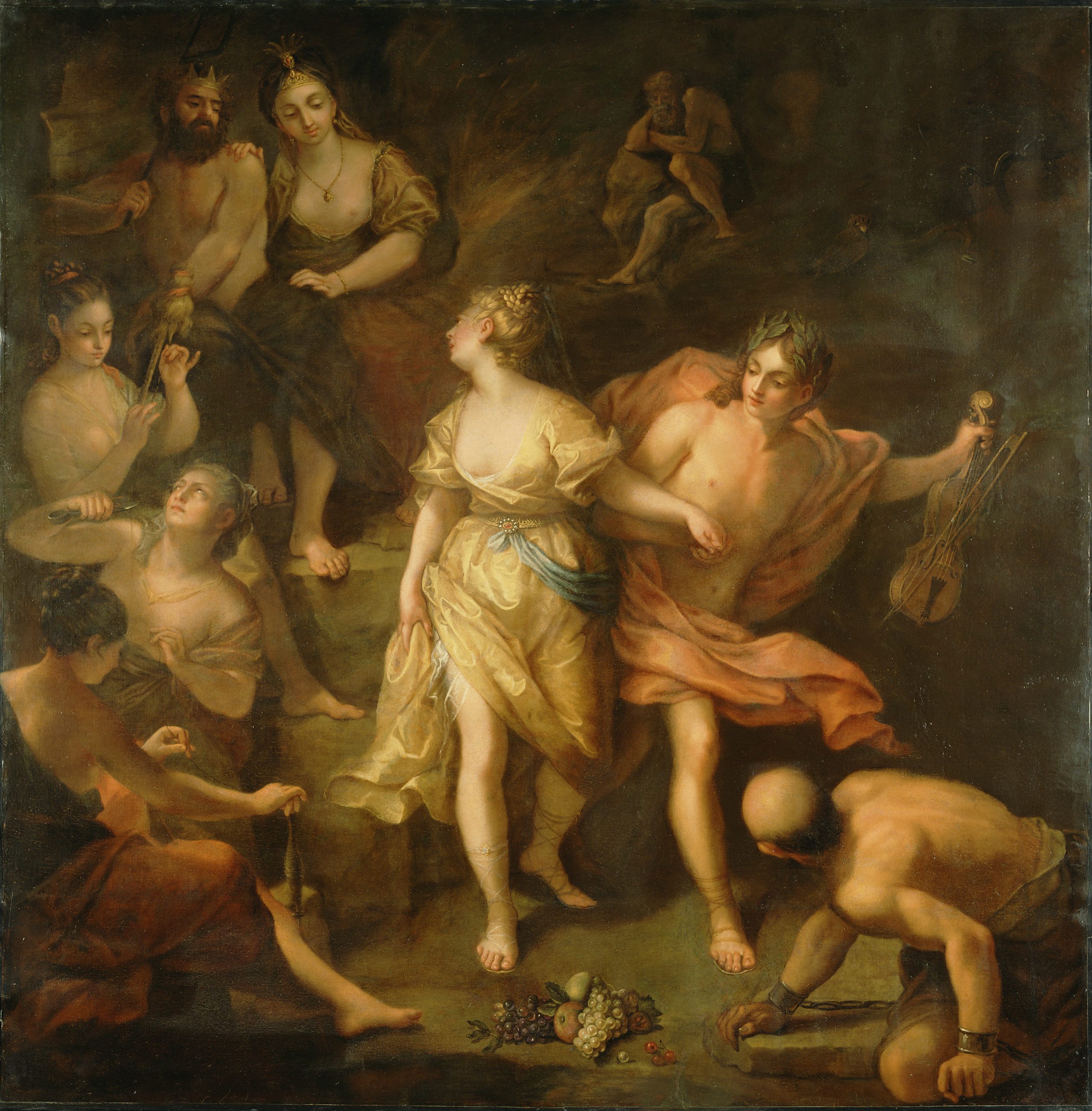
Jean Raoux (1677-1734) Orpheus and Eurydice. 1709. Getty Art Centre, New York. Public Domain. https://www.getty.edu/art/collection/object/103RD4#full-artwork-details
Metamorphoses: Transformations
Apollo and Daphne
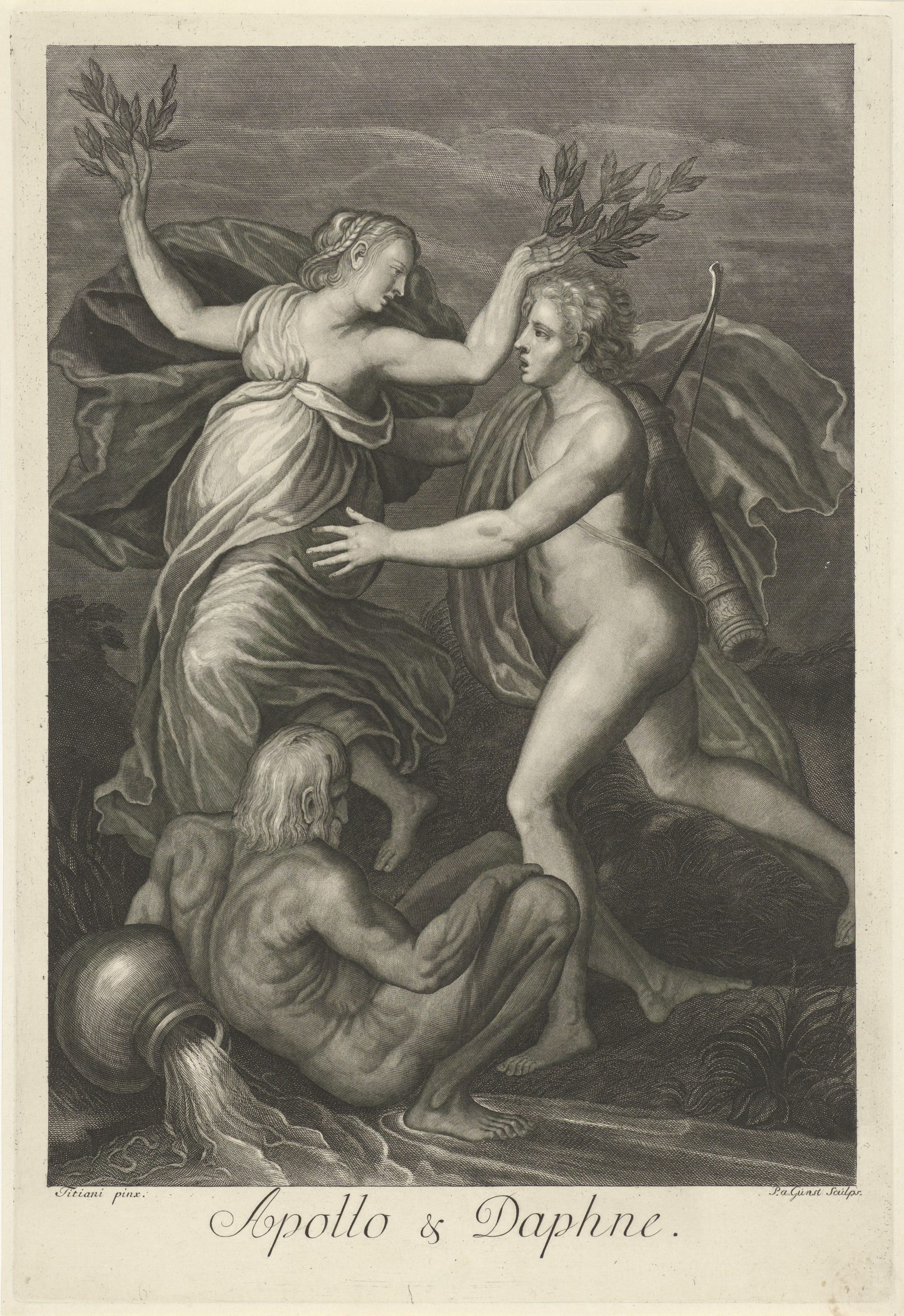
Pieter van Gunst (1659-1731), Engraving of Apollo and Daphne (turning into a tree). Gravura Engraving. Courtesy of The Rijksmuseum, Amsterdam, Netherlands. Public Domain. https://www.rijksmuseum.nl/en/collection/RP-P-OB-55.659
Apollo and Daphne (cont.)
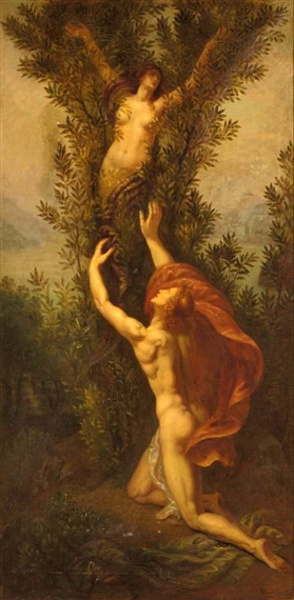
Armand Point (1860-1932) Daphne and Apollo. 1919. Courtesy of Wikimedia Commons. Public Domain. https://upload.wikimedia.org/wikipedia/commons/2/23/Armand_Point%2C_Apollo_And_Daphne%2C_1919.jpg
Daphne, Root Bound
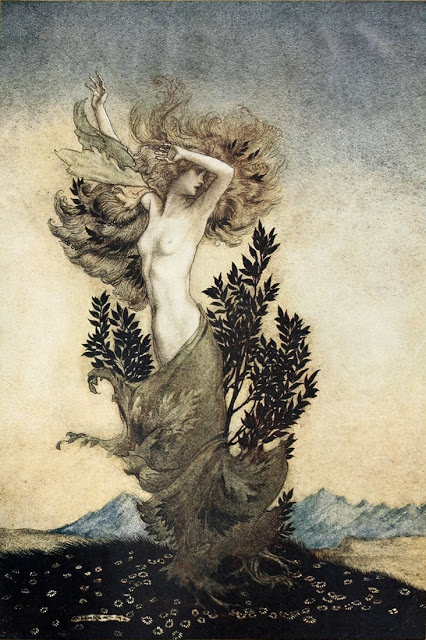
Arthur Rackham (1867-1939). Daphne, Root Bound. 1922. Illustration in a 1922 version of John Milton’s Comus (illustrated by Arthur Rackham). Courtesy of Wikimedia Commons. Public Domain. https://upload.wikimedia.org/wikipedia/commons/1/11/013_-%E2%80%A6_as_Daphne_was%2C_root-bound%2C_that_fled_Apollo.-.jpg
Apollo and Daphne the Wood Nymph: Excerpt from Bulfinches’ The Golden Age of Myth and Legend (Wordsworth Reference, 1993)
“Apollo loved her, and longed to obtain her; and he who gives oracles to all the world was not wise enough to look into his own fortunes. He saw her hair flung loose over her shoulders, and said, ‘If so charming in disorder, what would it be if arranged?’ He saw her eyes bright as stars; he saw her lips,and was not satisfied with only seeing them. He admired her hands and arms, naked to the shoulder, and whatever was hidden from view, more beautiful still… He followed her, she fled, swifter than the wind….
The nymph continued her flight….And even as she fled she charmed him. The wind blew her garments, and her unbound hair streamed lose behind her. The god grew impatient to find his wooings thrown away, and sped by Cupid, gained upon her in the race….Her strength begins to fail, and, ready to sink, she calls upon her father, the river god, “Help me Peneus!’ open the earth to enclose me, or change my form, which has brought me into this danger!’
Scarcely had she spoken when a stiffness seized all her limbs; her bosom began to be enclosed in a tender bark; her hair became leaves; her arms became branches; her foot stuck fast in the ground, as a root; her self became a tree top retaining nothing of its former self but its beauty….Apollo stood amazed. He embraced the branches, and lavished kisses on the wood. The branches shrank from his lips. ‘Since you cannot be my wife, ‘ said he, ‘you shall assuredly be my tree. I will wear you for my crown; I will decorate with you my harp and my quiver; and when the great Roman conquerors lead up the triumphal pomp to the Capital, you shall be woven into wreaths for their brow. And, as eternal youth is mine, you shall be green always, and your leaf know decay.’ The nymph, now changed into a Laurel tree, bowed its head in grateful acknowledgment.” (Wordsworth Reference, 1993, p. 15-16)
The Transformation of Narcissus
Narcissus
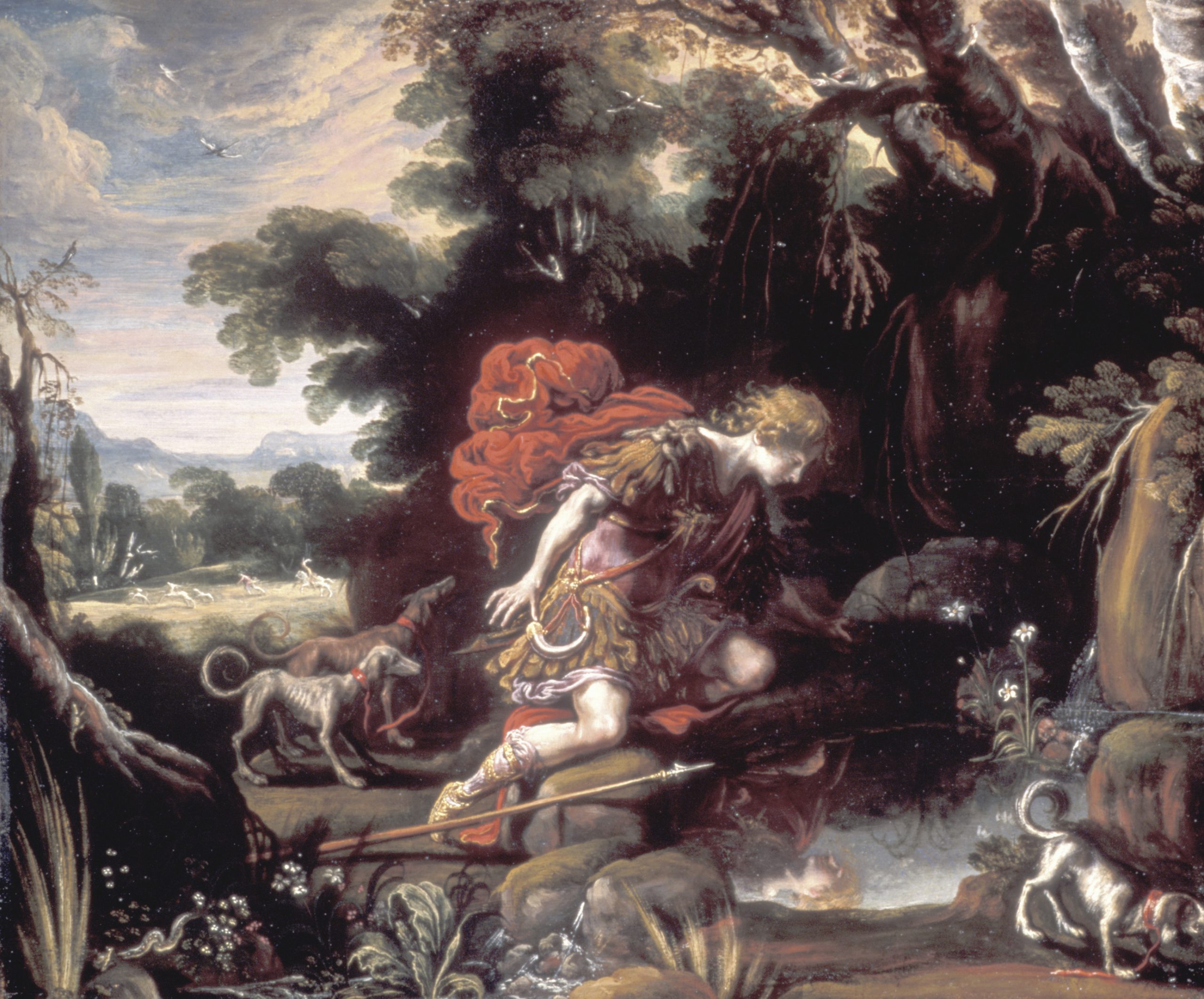
Claude Vignon (1593-1670), Narcissus, Indianapolis Museum of Art. Indiana, US. Public Domain. https://upload.wikimedia.org/wikipedia/commons/c/c2/Claude_Vignon_-_Narcissus_-_80.361_-_Indianapolis_Museum_of_Art.jpg
Learning Objectives
For more information on Narcissus, please follow the link below:
Source: https://www.greekmythology.com/Myths/Mortals/Narcissus/narcissus.html
“The mountain nymph Echo fell in love with the hunter Narcissus. Echo could not convey her affection for Narcissus because she could only repeat his last words. Narcissus was impatient, harsh, and dismissive. He rejected her. Sometime later he sees his reflection in a pool of water. So enamoured with the beautiful image reflected back, Narcissus fell in love with his own reflection. “He pined away and died turning into a flower called the “Narcissus” in his honour. And we still call anyone who is extremely conceited ‘narcissistic.’ As for Echo, she pined away too, until nothing was left of her but her voice, which is still to be heard in the mountains of which she was a nymph. Her voice is still called an ‘echo.’ (Asimov, 1961, p. 88)
Narcissus
Echo
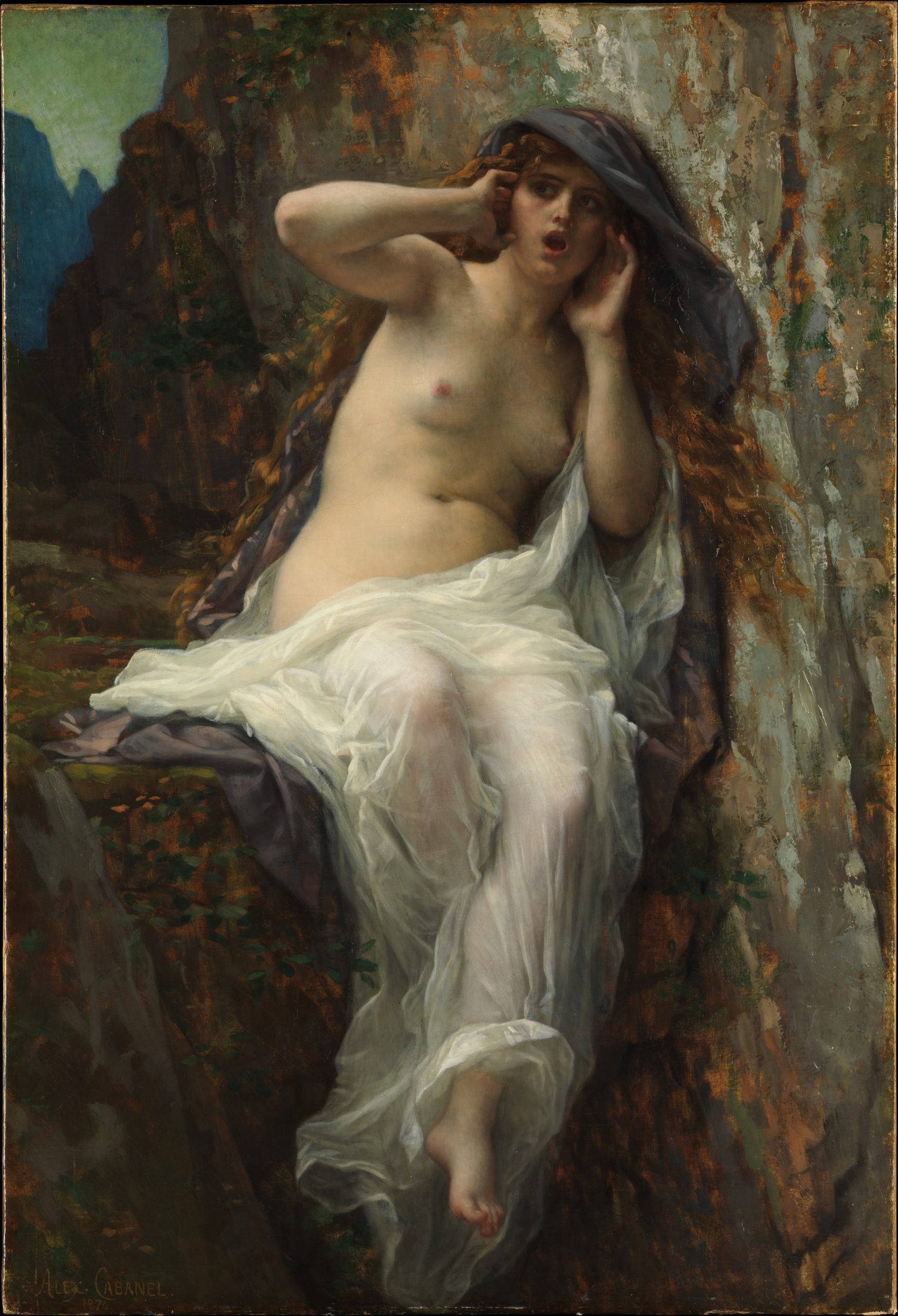
Alexandre Cabanel (1823-1889) Echo. 1874. Courtesy of the Metropolitan Museum of Art. Public Domain. https://upload.wikimedia.org/wikipedia/commons/8/83/Alexandre_Cabanel_-_Echo.jpg
Metropolitan Museum of Art Detail:
- Echo – Gift of Mary Phelps Smith, in memory of her husband, Howard Caswell Smith. 1965. New York City
“In Greek mythology, the beautiful nymph Echo is cursed by the goddess Hera and can only repeat the last words said to her. Unable to communicate with the man she loves, Echo retreats to the mountains and pines away until just her voice remains. This painting depicts the nymph with her mouth agape and her hands at her ears as if startled by reverberating sounds. The mannered elegance and polished handling of the figure epitomize the style promoted by the influential French Académie des Beaux-Arts. Nineteenth-century critics often deemed such idealized portrayals of the nude unconvincing, but many viewers preferred them to more realistic depictions, which seemed shockingly indecorous.” (Alexandre Cabanel | Echo | The Metropolitan Museum of Art (metmuseum.org)
In Greek mythology, the beautiful nymph Echo is cursed by the goddess Hera and can only repeat the last words said to her. Unable to communicate with the man she loves, Echo retreats to the mountains and pines away until just her voice remains. This painting depicts the nymph with her mouth agape and her hands at her ears as if startled by reverberating sounds. The mannered elegance and polished handling of the figure epitomize the style promoted by the influential French Académie des Beaux-Arts. Nineteenth-century critics often deemed such idealized portrayals of the nude unconvincing, but many viewers preferred them to more realistic depictions, which seemed shockingly indecorous.
The Myth of Orpheus and Eurydice in Art, Poetry, and Prose
Orpheus and Landscape
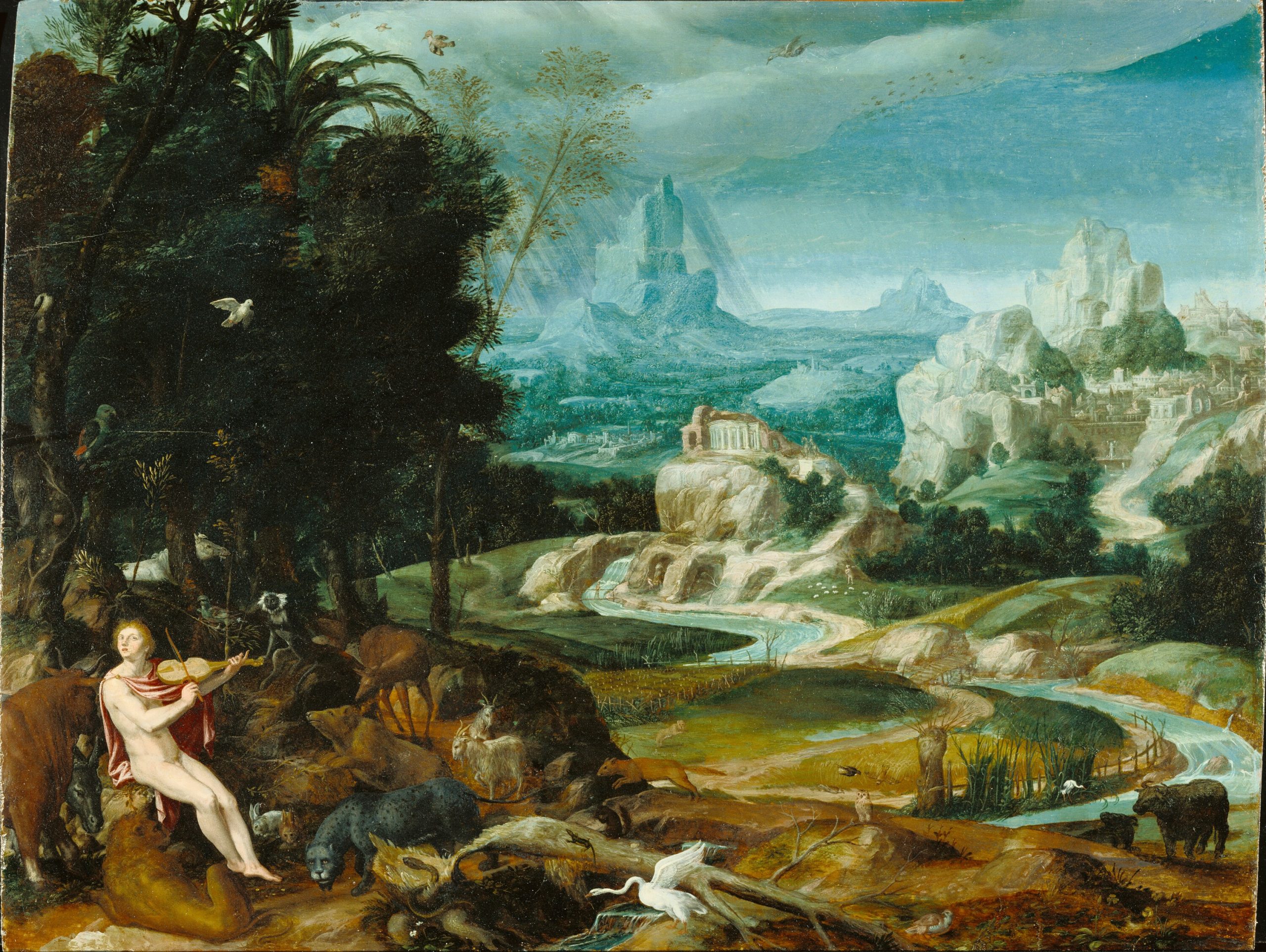
Unknown Flemish Artist, 16th Century. Orpheus and Landscape. Courtesy of the Getty Art Centre, Getty Museum. Los Angeles, California, US. Public Domain. https://commons.wikimedia.org/wiki/File:Landscape_with_Orpheus_00067001.jpg
Orpheus’ music was said to enchant not only animals but trees, flowers, and rocks. The story of Orpheus and Eurydice is one of the most well-known in Greek and Roman mythology.
Garden of Eden
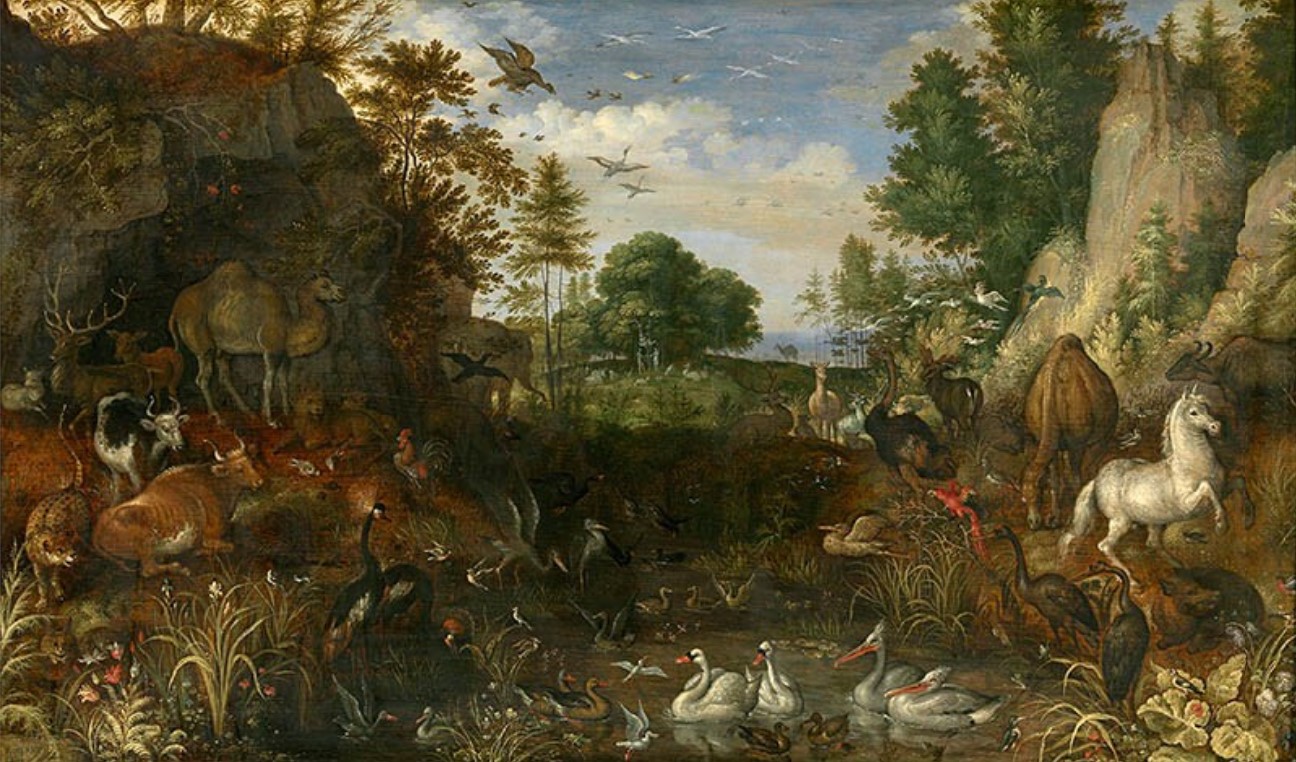
Rolant Savery (1576-1639), Garden of Eden (early 17th century). Royal Museum of Antwerp, Antwerp, Belgium. Public Domain. https://commons.wikimedia.org/wiki/File:Roelant_Savery_-_The_Garden_of_Eden_-_WGA20883.jpg
Mythic Stories, Legends, and Fables: Art, Poetry, and Prose
The great tragic dramas of Sophocles (497/496 BC-406/405 BC) touch on universal human themes and emotions. One of the most famous art images of Oedipus and the Sphinx was painted by Gustav Moreau. An excerpt from Thomas Bullfinch’s The Golden Age of Myth and Legend complement the image. For more information about the plays of Oedipus, a link can be found below.
Oedipus and the Sphnix: Can you avoid destiny or can you alter fate? How important are awareness, empathy, and knowledge—self-knowledge, knowledge of one’s family, and knowledge of history?
In the Greek story, the Sphinx was a female monster with the face and upper body of a woman with the body of a bird or lion. She was sent by Hera as a curse on the City of Thebes. In the story, Laius, King of Thebe, is warned by an oracle that his life and position on the throne would be endangered if his new-born son should live. Laius gives his son to a herdsman with the belief that the herdsman would kill his son. Not having the heart to do so, the herdsman ties the child to a tree and is left hanging by his feet. A shepherd saves the baby’s life and adopts him naming him “Oedipus” (Swollen Foot). A series of extraordinary events determine the fates of Oedipus, his father, mother, children, and the people of Thebes.
Excerpt from The Golden Age of Myth and Legend by Thomas Bulfinch (1796-1867):
“Many years afterward Laius, being on his way to Delphi, accompanied only by one attendant, met in a narrow road a young man also driving in a chariot. On his refusal to leave the way at their command the attendant killed one of his horses, and the stranger, filled with rage, slew both Laius and his attendant. The young man was Oedipus, who thus unknowingly became the slayer of his own father.
Shortly after this event the city of Thebes was afflicted with a monster which infested the high road. It was called the Sphinx. It had the body of a lion and the upper part of a woman. It lay crouched on the top of the rock, and arrested all travellers who aim that way, proposing to them a riddle, with the condition that those who could solve it should pass safe, but those who failed should be killed. Not one had yet succeeded in solving it, and all had been slain. Oedipus was not daunted by these alarming accounts, but boldly advanced to the trial. The Sphinx asked him, ‘What animal is that which in the morning goes on four feet, at noon on two, and in the evening upon three?’ Oedipus replied, ‘Man, who in childhood creeps on hands and knees, in manhood, walks erect, and in old age with the aid of a staff.’ The Sphinx was so mortified at the solving of her riddle that she cast herself down from the rock and perished.
The gratitude of the people for their deliverance was so great that they made Oedipus their king, giving him in marriage their queen Jocasta. Oedipus, ignorant of his parentage, had already become the slayer of his father; in marrying the queen he became the husband of his mother. These horrors remained the undiscovered till at length Thebes was afflicted with famine and pestilence, and the oracle being consulted, the double crime of Oedipus came to light. Jocasta put an end to her own life, and Oedipus, seized with madness, tore out his eyes and wandered away from Thebes, dreaded and abandoned by all except his daughts, who faithfully adhered to him….”( Thomas Bulfinch, 1855/1993, The golden age of myth and legend, Chapter 10, p. 124, Wordsworth Reference Books. ( Retrieved August 21, 2023 https://www.online-literature.com/bulfinch/mythology_fable/10/).
Project Gutenberg eBook:
https://www.gutenberg.org/files/56644/56644-h/56644-h.htm
Oedipus and the Riddle of Sphinx
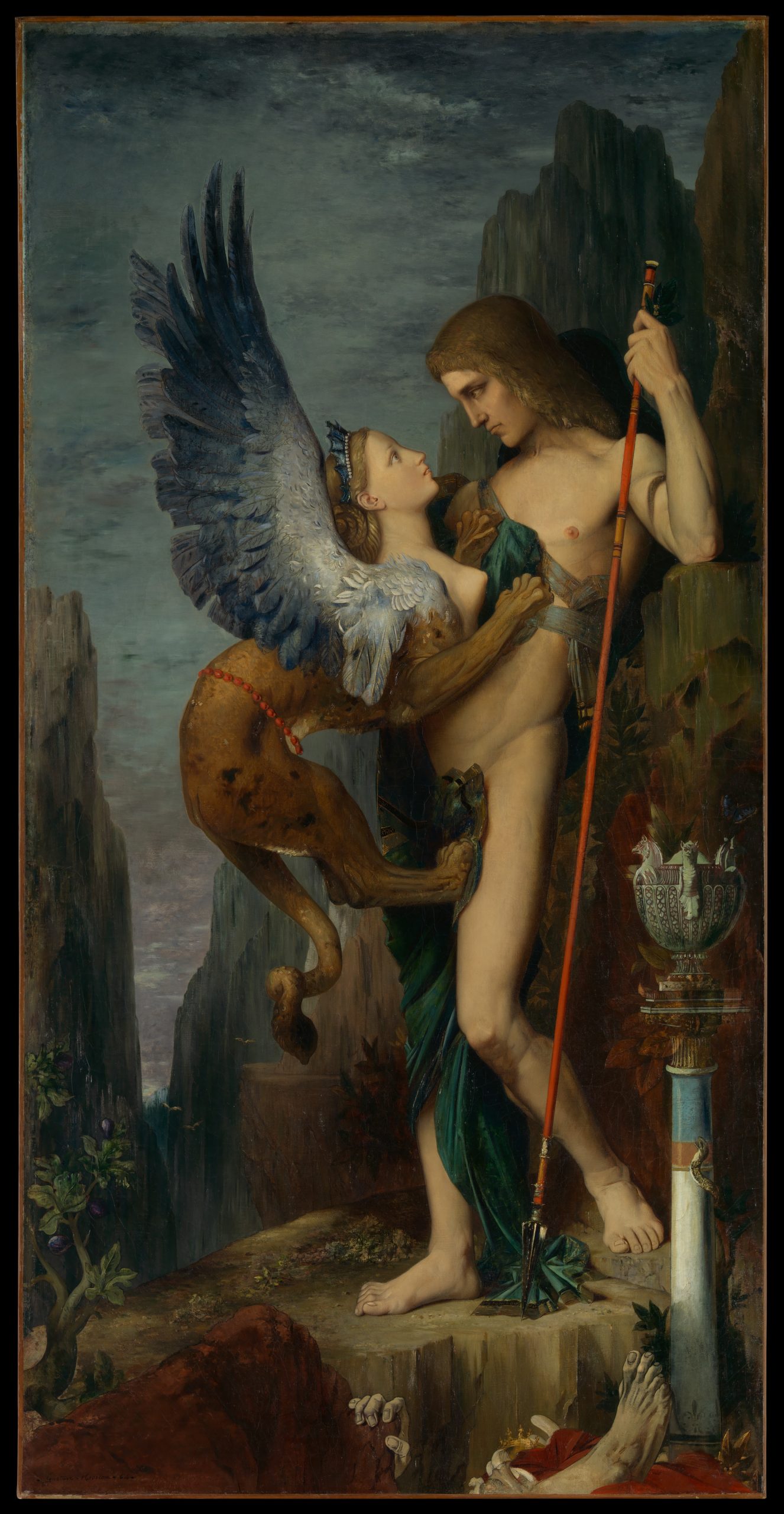
Gustave Moreau, 1826-1898, Oedipus and the Riddle of Sphinx, 1864, Metropolitan Museum of Art. New York City, NY. Public Domain. This file was donated to Wikimedia Commons as part of a project by the Metropolitan Museum of Art. See the Image and Data Resources Open Access Policy, CC0, https://commons.wikimedia.org/w/index.php?curid=65099463
Key Takeaways
This file was donated to Wikimedia Commons as part of a project by the Metropolitan Museum of Art. See the Image and Data Resources:
https://commons.wikimedia.org/w/index.php?curid=65099463
For more information about Gustave Moreau’s painting please open the MET link here:
Learning Objectives
Summary of Oedipus:
https://www.theguardian.com/books/2008/jan/15/greekmyths.greekmythsfeatures4
For the complete Sophocles trilogy: Oedipus the King, Antigone, and Oedipus at Colonus (The Oedipus Trilogy) please open the Project Gutenberg link below:
Aesop’s Fables: Juno and the Peacock
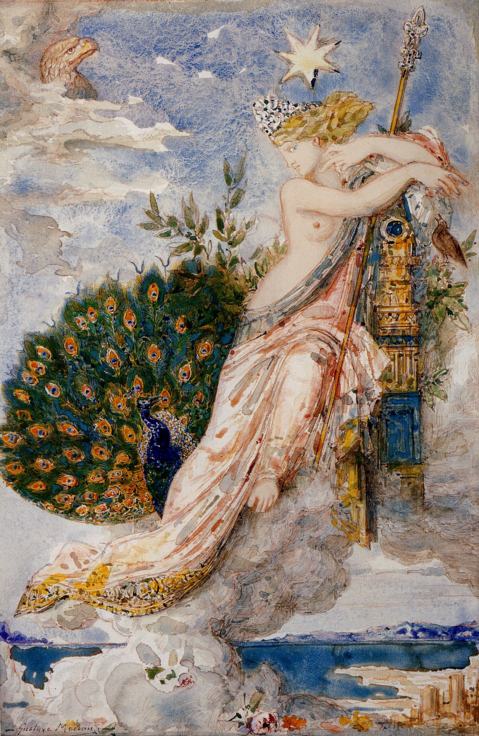
Gustave Moreau (1826-1898), The Peacock Complaining to Juno, 1881, Musee Gustave Moreau. Courtesy of Wikimedia Commons. Public Domain. https://commons.wikimedia.org/wiki/File:Gustave_Moreau_-_Le_Paon_se_plaignant_à_Junon.jpg
In Roman mythology, Juno was the queen of the heavens and she rode a chariot flown by peacocks. She was both the wife and sister of Jupiter (father/King of the heavens). From Aesop’s Fables (Project Gutenberg). Aesop was a Greek story teller (620-564 B.C.E.). His fables and morality tales are among the most well known worldwide. In his fables insects, animals, and inanimate objects face challenges, solve problems, and possess human character traits.
“The Peacock was greatly discontented because he had not a beautiful voice like the nightingale, and he went and complained to Juno about it. “The nightingale’s song,” said he, “is the envy of all the birds; but whenever I utter a sound I become a laughing-stock.” The goddess tried to console him by saying, “You have not, it is true, the power of song, but then you far excel all the rest in beauty: your neck flashes like the emerald and your splendid tail is a marvel of gorgeous colour.” But the Peacock was not appeased. “What is the use,” said he, “of being beautiful, with a voice like mine?” Then Juno replied, with a shade of sternness in her tones, “Fate has allotted to all their destined gifts: to yourself beauty, to the eagle strength, to the nightingale song, and so on to all the rest in their degree; but you alone are dissatisfied with your portion. Make, then, no more complaints. For, if your present wish were granted, you would quickly find cause for fresh discontent.”
Retrieved August 28, 2022. Aesop’s Fables. G.K. Chesterton’s Aesop’s Fables (1912). https://www.gutenberg.org/files/11339/113390h/11339-h.htm
Learning Objectives
To read Aesop’s collection of fables, please open the link below:
1912 Vernon Jones’ Aesop’s Fables (Illustrated by Arthur Rackham), Project Gutenberg. https://www.gutenberg.org/files/11339/11339-h/11339-h.htm
Juno is Seated on the Clouds and Addresses a Peacock Standing on a Mound
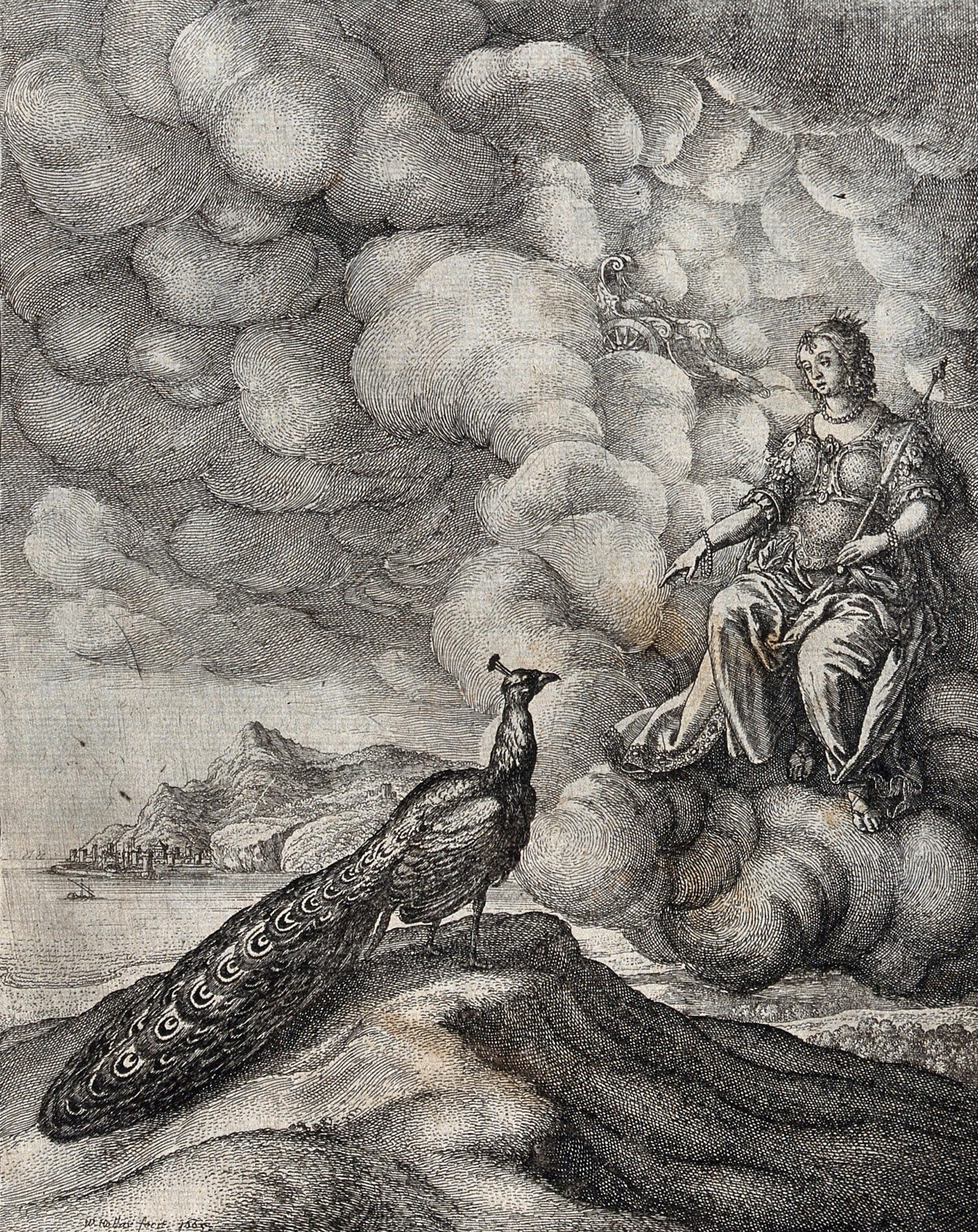
Wenceslaus Hollar (1607-1677). Juno is Seated on the Clouds and Addresses a Peacock Standing on a Mound, 1665; Illustration of John Ogilby (1600-1676) “Aesopicks”. Etching by Wenceslaus Hollar. Courtesy of the Iconographic Collections, Welcome Library. Public Domain. http://catalogue.wellcomelibrary.org/record=b1197453
Stories and Fables from the Golden Age of Mythology
Flowers from Shakespeare’s Garden: Juno
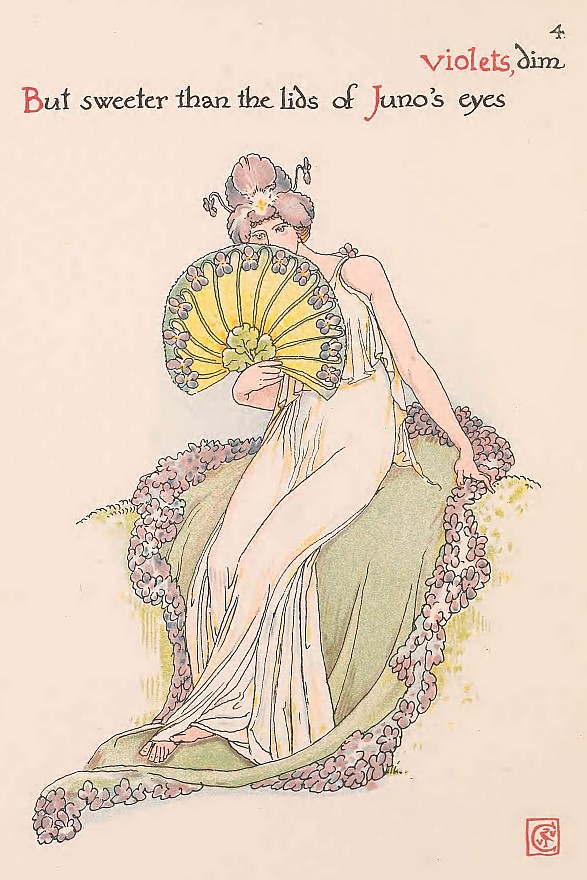
Walter Crane (1845-1915). Illustration in “Flowers from Shakespeare’s Garden: A Posy from the Plays by William Shakespeare”. 1909. Water colour on canvas. Courtesy of Project Gutenberg. Public Domain. https://www.gutenberg.org/files/64102/64102-h/64102-h.htm
For more information on artwork, myths, legends, and stories:
Aesop Fables, a collection by Vernon Jones:
https://www.gutenberg.org/files/11339/11339-h/11339-h.htm
Walter Crane was one of the most creative illustrators and artists during the Golden Age of Illustration. For further insights into the books he illustrated, please open the link below:
https://www.gutenberg.org/files/32242/32242-h/32242-h.htm
The Story of Greece by Mary MacGregor.
https://www.gutenberg.org/files/66070/66070-h/66070-h.htm
Golden Age of Illustration in Book Design and Illustration (1880s-1920s):
he Golden Age of Illustration was a period of unprecedented excellence in book and magazine illustration. It developed from advances in technology permitting accurate and inexpensive reproduction of art, combined with a voracious public demand for new graphic art.
In Europe, Golden Age artists were influenced by the Pre-Raphaelites and by such design-oriented movements as the Arts and Crafts Movement, Art Nouveau, and Les Nabis. Leading artists included Walter Crane, Edmund Dulac, Aubrey Beardsley, Arthur Rackham and Kay Nielsen.
American illustration of this period was anchored by the Brandywine Valley tradition, begun by Howard Pyle and carried on by his students, who included N.C. Wyeth, Maxfield Parrish, Frank Schoonover and Edwin Austin Abbey.
King Midas and Apollo
We refer to someone who is particularly successful in business as having “the Midas touch” (all that the individuals touches seems to turn out to be gold). The phrase has a more ominous message about the short-comings of greed and the failure to appreciate true value when we read the myth of King Midas. Midas’s wish is granted by Apollo but the wish soon becomes a curse. Anything he tried to eat and drink turned to gold and he was soon threatened by starvation. When he touched his daughter, she turned into a golden statue. As punishment for his avarice, Apollo gives Midas donkey’s ears.
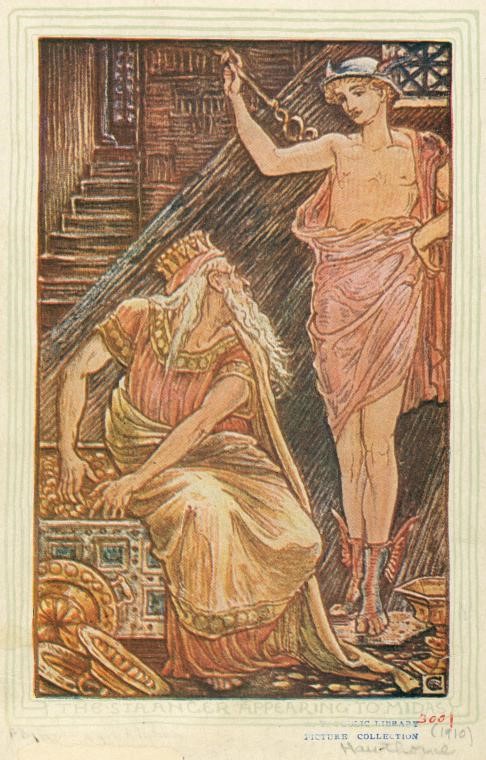
Walter Crane (1845-1915), The Stranger Appearing to Midas. Illustration from Nathaniel Hawthorne (1804-1864), The Wonder Book for Boys and Girls. Houghton Miflin, Library of Congress, Illustration by Walter Crane, 1893. (p.50). Public Domain. https://digitalcollections.nypl.org/items/510d47e4-6069-a3d9-e040-e00a18064a99
Midas’ Daughter Turned to Gold
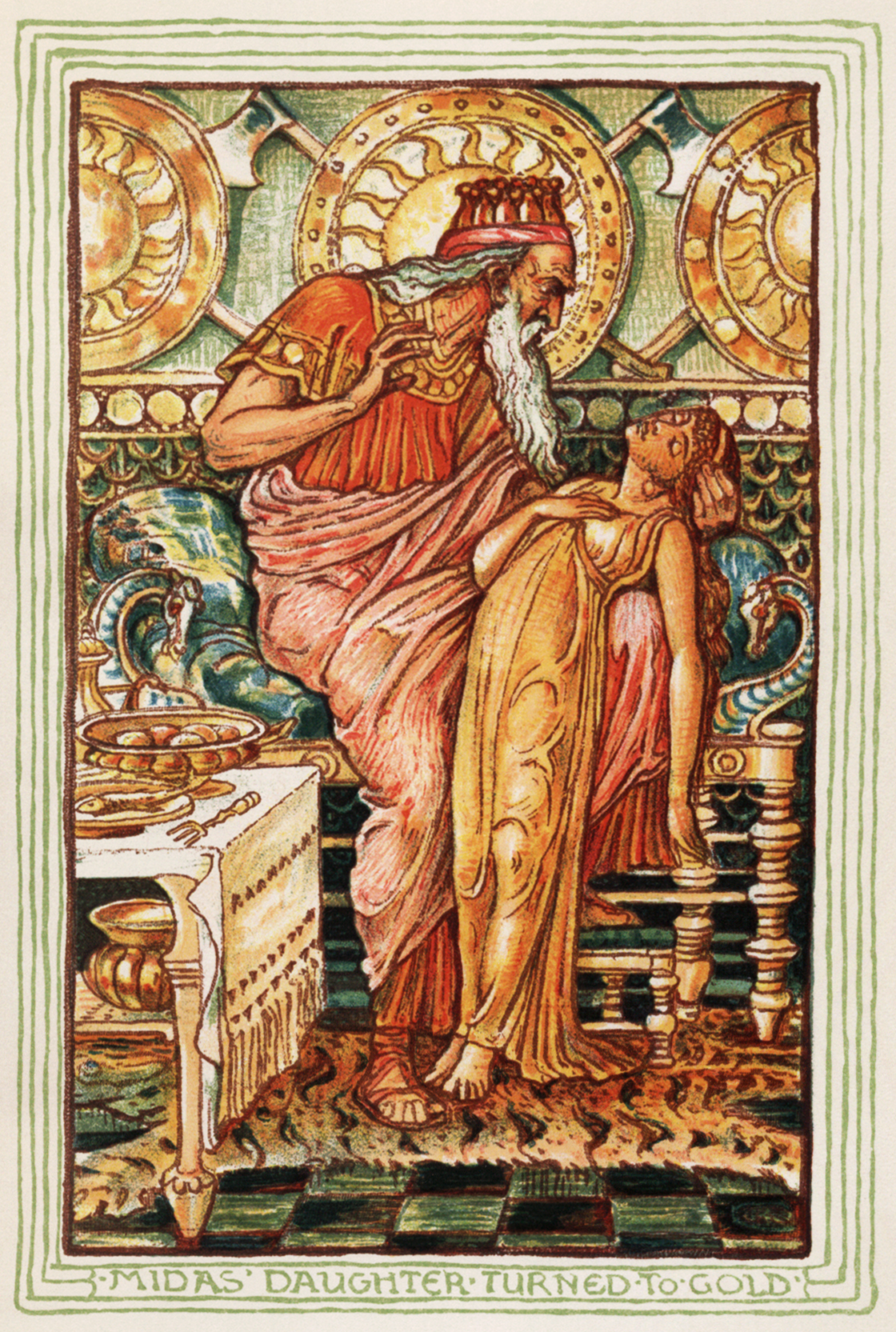
Walter Crane (1759-1828). Midas’ Daughter Turned to Gold. Illustration in The Wonder Tales by Nathaniel Hawthorn (1804-1864). Courtesy of Project Gutenberg. Public Domain. https://en.wikipedia.org/wiki/File:Midas_gold2.jpg
Learning Objectives
Excerpt from King Midas:
“This King Midas was fonder of gold than of anything else in the world. He valued his royal crown chiefly because it was composed of that precious metal. If he loved anything better, or half so well, it was the one little maiden who played so merrily around her father’s footstool. But the more Midas loved his daughter, the more did he desire and seek for wealth. He thought, foolish man! that the best thing he could possibly do for this dear child would be to bequeath her the immense pile of yellow, glistening coin, that had ever been heaped together since the world was made. Thus, he gave all his thoughts and all his time to this one purpose. If ever he happened to gaze for an instant at the gold-tinted clouds of sunset, he wished that they were real gold, and that they could be squeezed safely into his strong box. When little Marygold ran to meet him, with a bunch of buttercups and dandelions, he used to say, “Poh, poh, child! If these flowers were as golden as they look, they would be worth the plucking!”
And yet, in his earlier days, before he was so entirely possessed of this insane desire for riches, King Midas had shown a great taste for flowers. He had planted a garden, in which grew the biggest and beautifullest and sweetest roses that any mortal ever saw or smelt. These roses were still growing in the garden, as large, as lovely, and as fragrant, as when Midas used to pass whole hours in gazing at them, and inhaling their perfume. But now, if he looked at them at all, it was only to calculate how much the garden would be worth if each of the innumerable rose-petals were a thin plate of gold. And though he once was fond of music (in spite of an idle story about his ears, which were said to resemble those of an ass), the only music for poor Midas, now, was the chink of one coin against another.” (Hawthorne, p.47).
For the complete story please open the links below:
The Project Gutenberg eBook of A Wonder Book for Girls & Boys, by Nathaniel Hawthorne https://www.gutenberg.org/files/32242/32242-h/32242-h.htm
For more on King Midas:
The Cover of Theo Marzials’ 1883 Songbook: Pan Pipes

Walter Crane (1845-1915). The cover of Theo Marzials’ 1883 songbook: Pan Pipes. Courtesy of Project Gutenburg. Public Domain. https://www.gutenberg.org/ebooks/author/7195 or https://upload.wikimedia.org/wikipedia/commons/7/7c/Marzials%27s_Pan_Pipes.jpg
Key Takeaways
The Golden Age of Illustration featured the great art work of Walter Crane and Arthur Rackham. For more information about these artists please open the link below:
https://en.wikipedia.org/wiki/File:Marzials%27s_Pan_Pipes.jpg
The Judgement of Midas
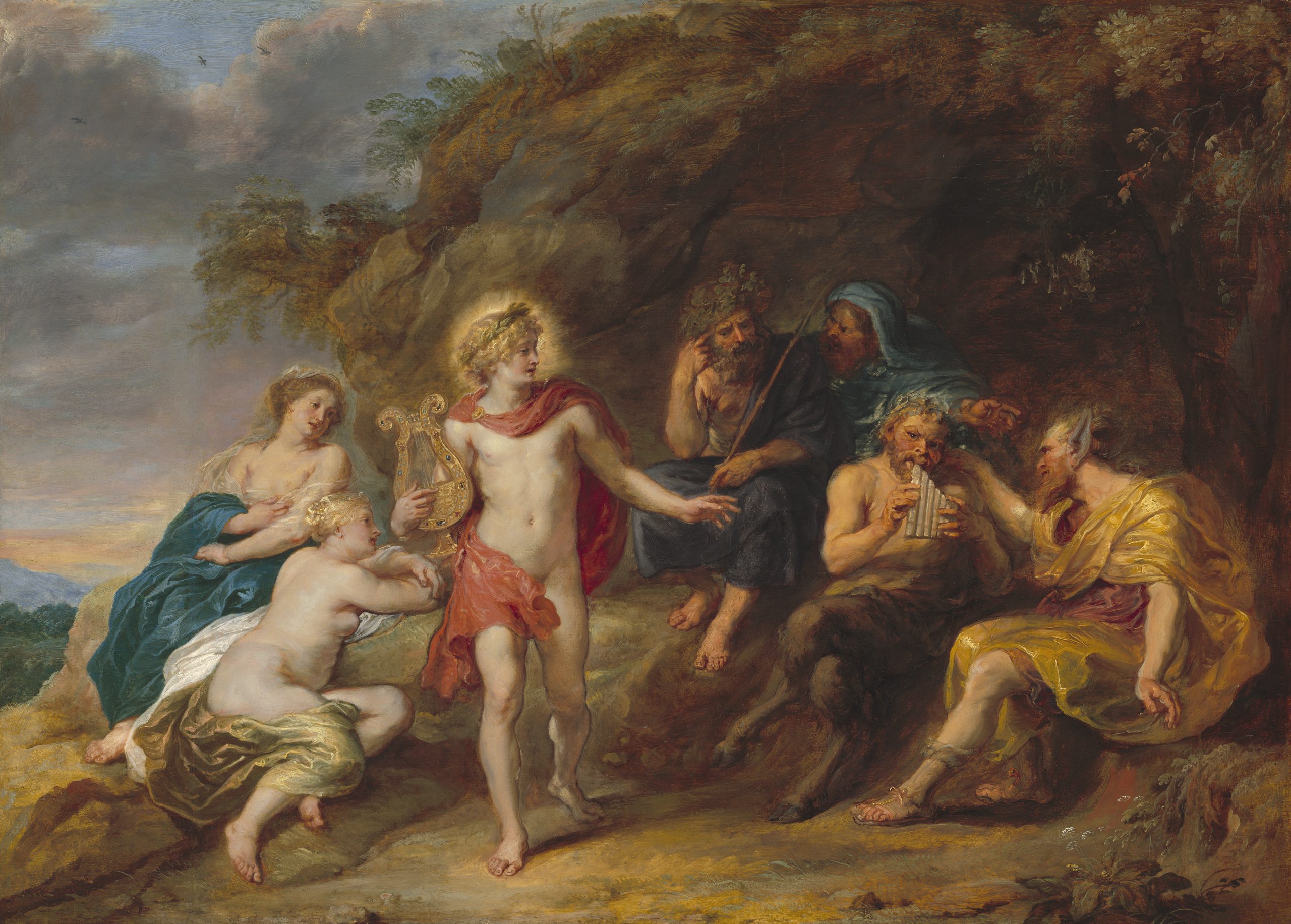
Jan Van Den Hoecke (1611 – 1651), The Judgement of Midas. 1640. Courtesy of the he National Gallery of Art, Concoran Gallery, Washington, DC. Wikimedia Commons, Open Access Collection. https://upload.wikimedia.org/wikipedia/commons/7/79/Jan_van_den_Hoecke%2C_The_Judgment_of_Midas%2C_c._1640%2C_NGA_195617.jpg
Note on the painting Judgement of Midas:
The Judgement of Midas depicts a musical contest between Pan (God of the fields and shepherds) and Apollo (God of Music and the Sun). While Pan is featured with a pipe and goat legs, Apollo appears glowing and radiant. Apollo signals to King Midas (featured in this painting with donkey’s ears–Apollo’s punishment for his vanity and greed) to begin the contest. An audience which include varied forest deities and nymphs awaits the contest.
Musical Contest between Apollo and Pan
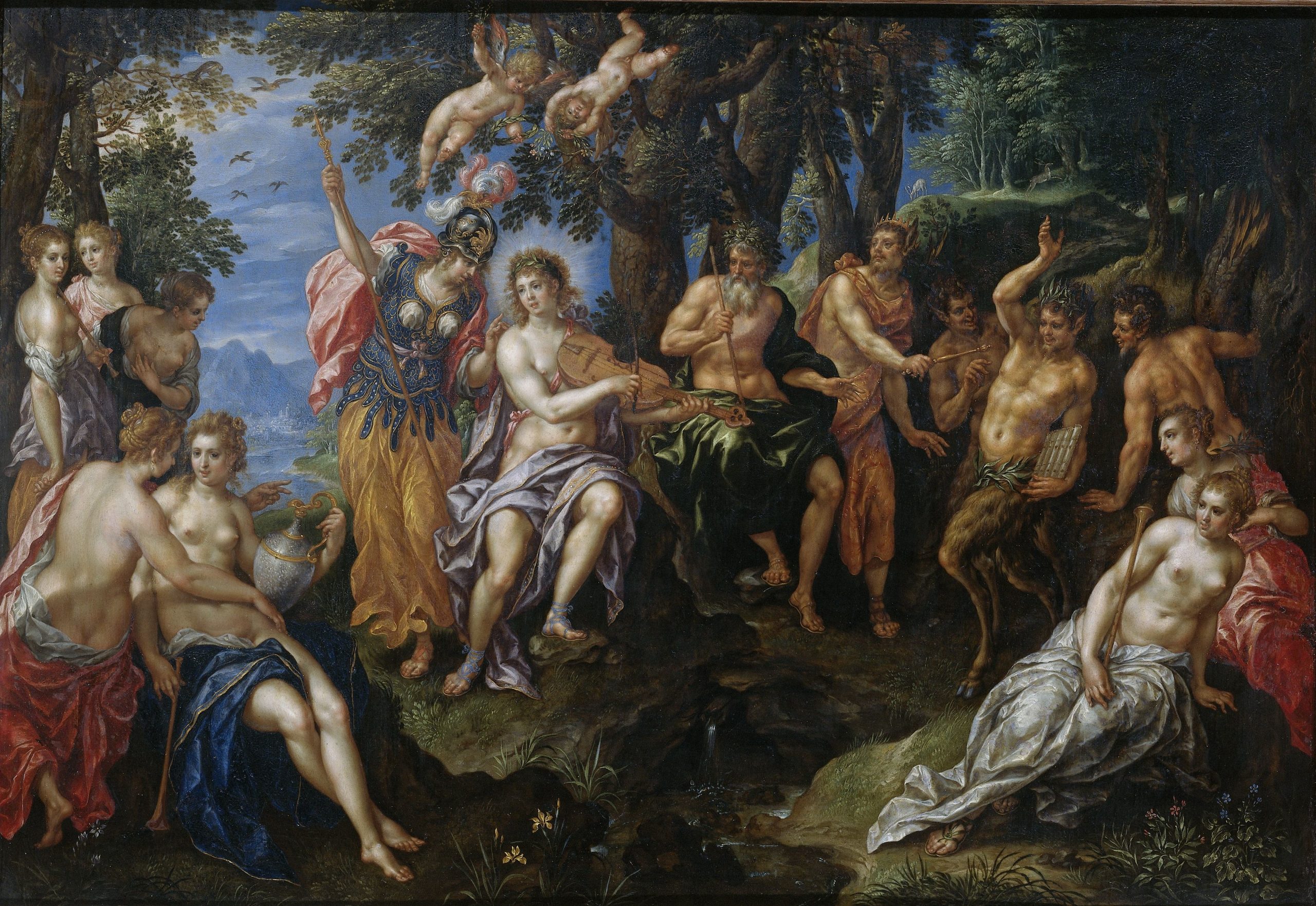
Hendrik de Clerck (1560/70 – 1630), The contest between between Apollo (God of Music) and Pan (God of Nature). 1620. Rijksmuseum Amsterdam, Netherlands. Public Domain. The_Contest_between_Apollo_and_Pan_by_Hendrik_de_Clerck_Clerck_Rijksmuseum_Amsterdam_SK-A-621.jpg (3906×2690) (wikimedia.org)

